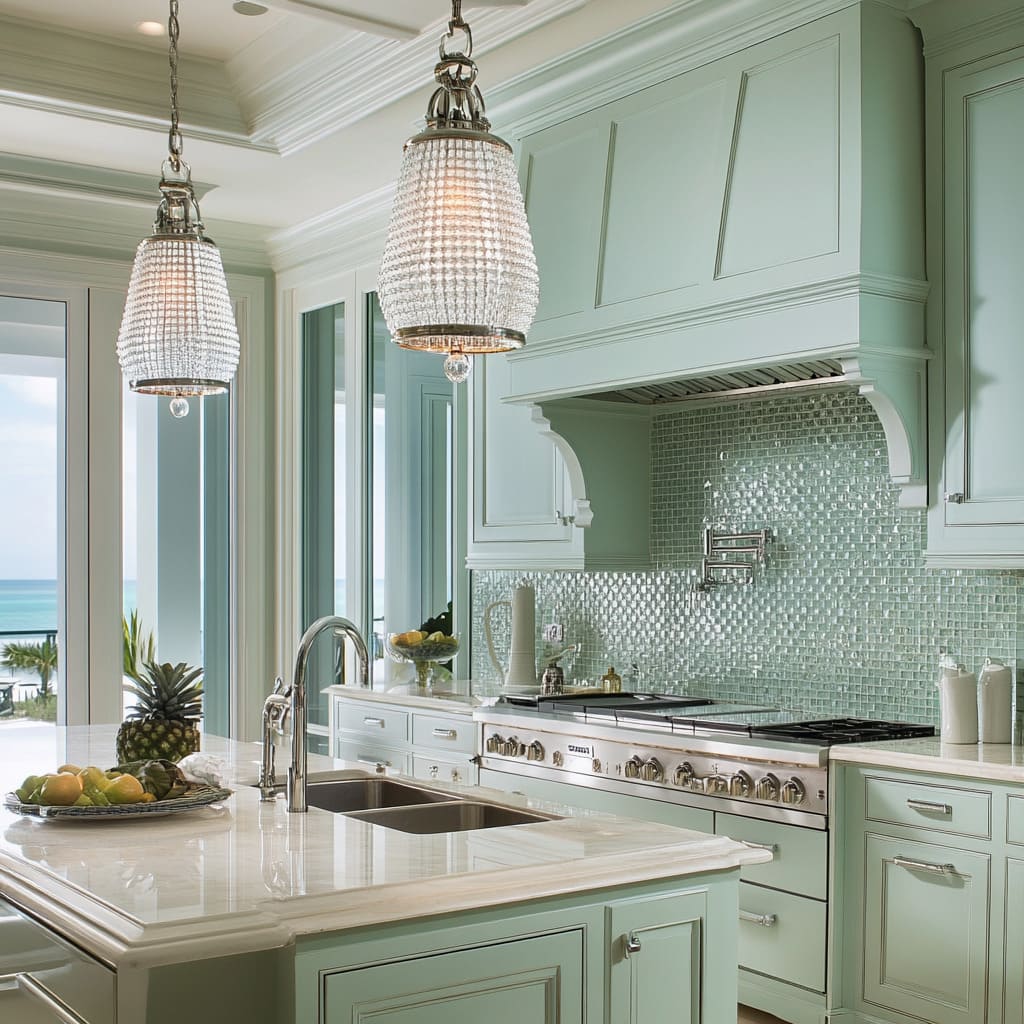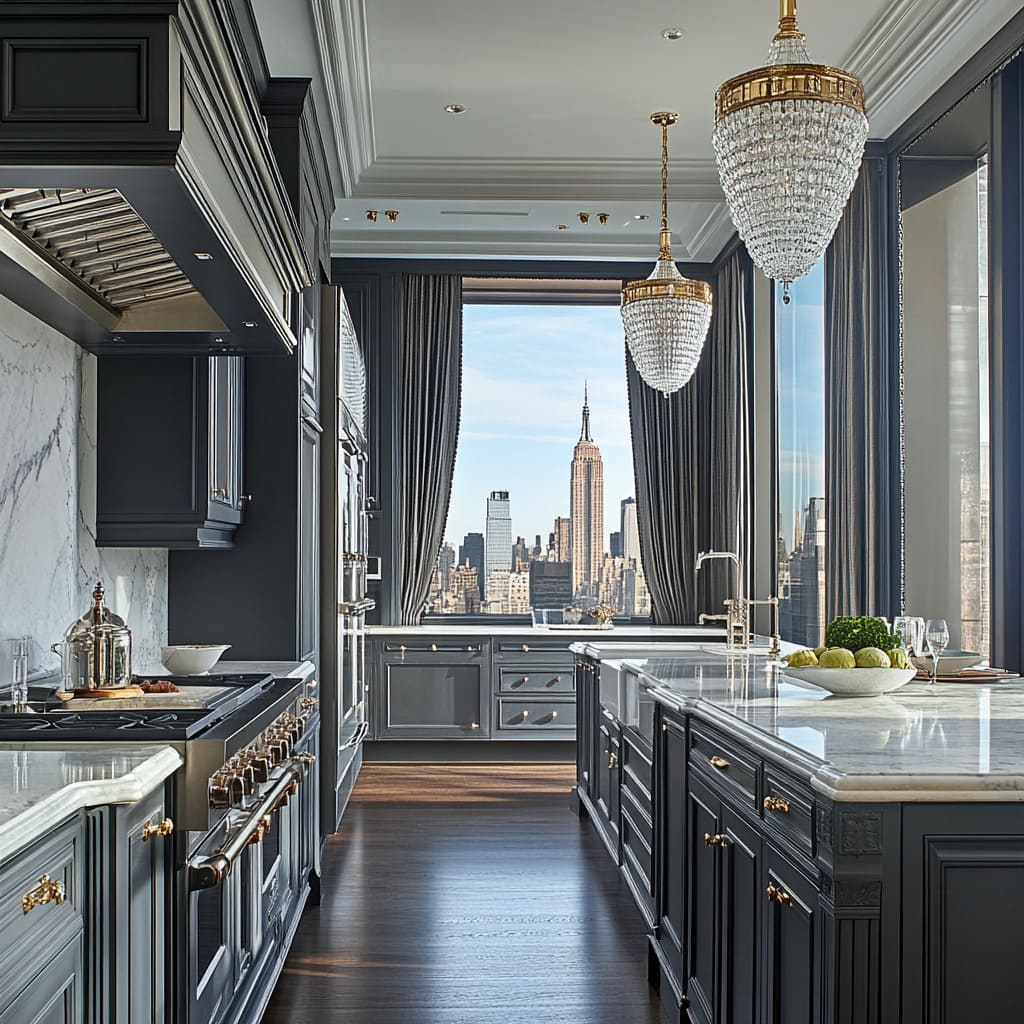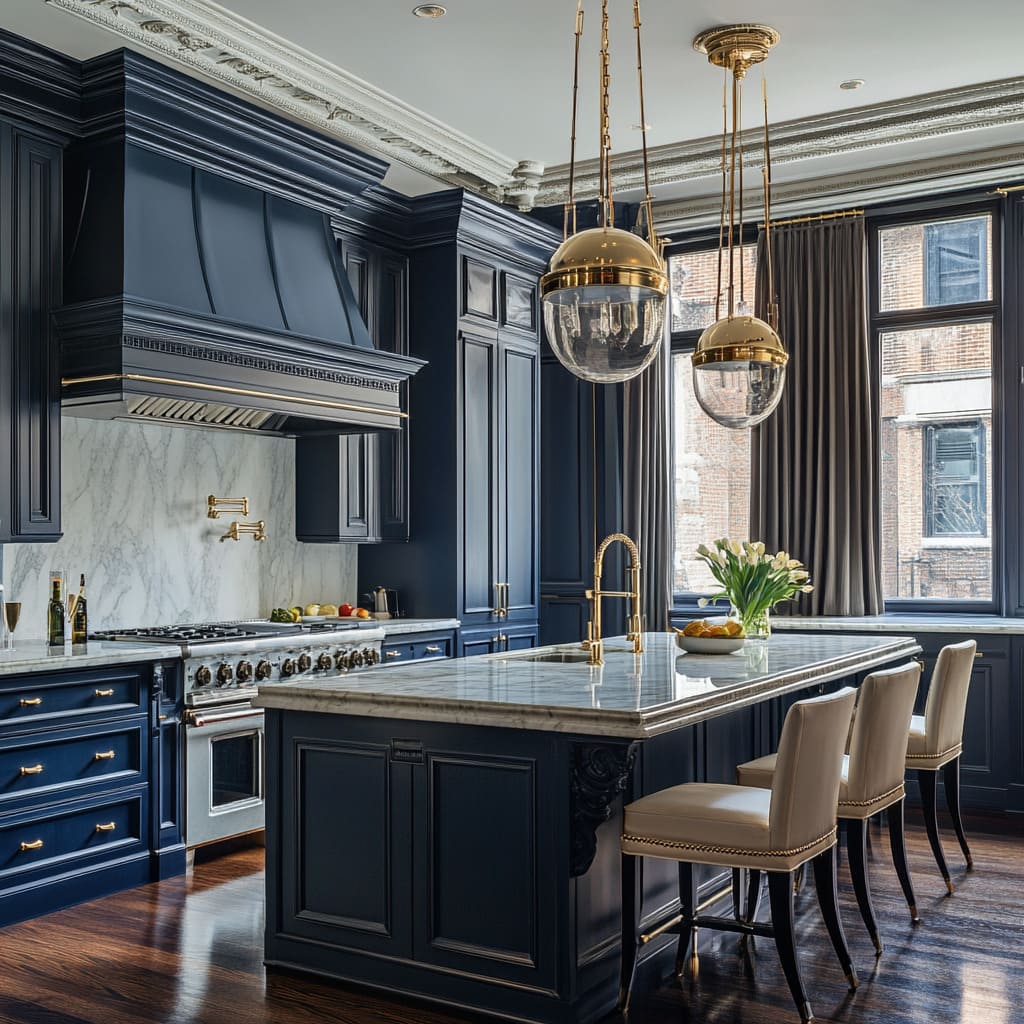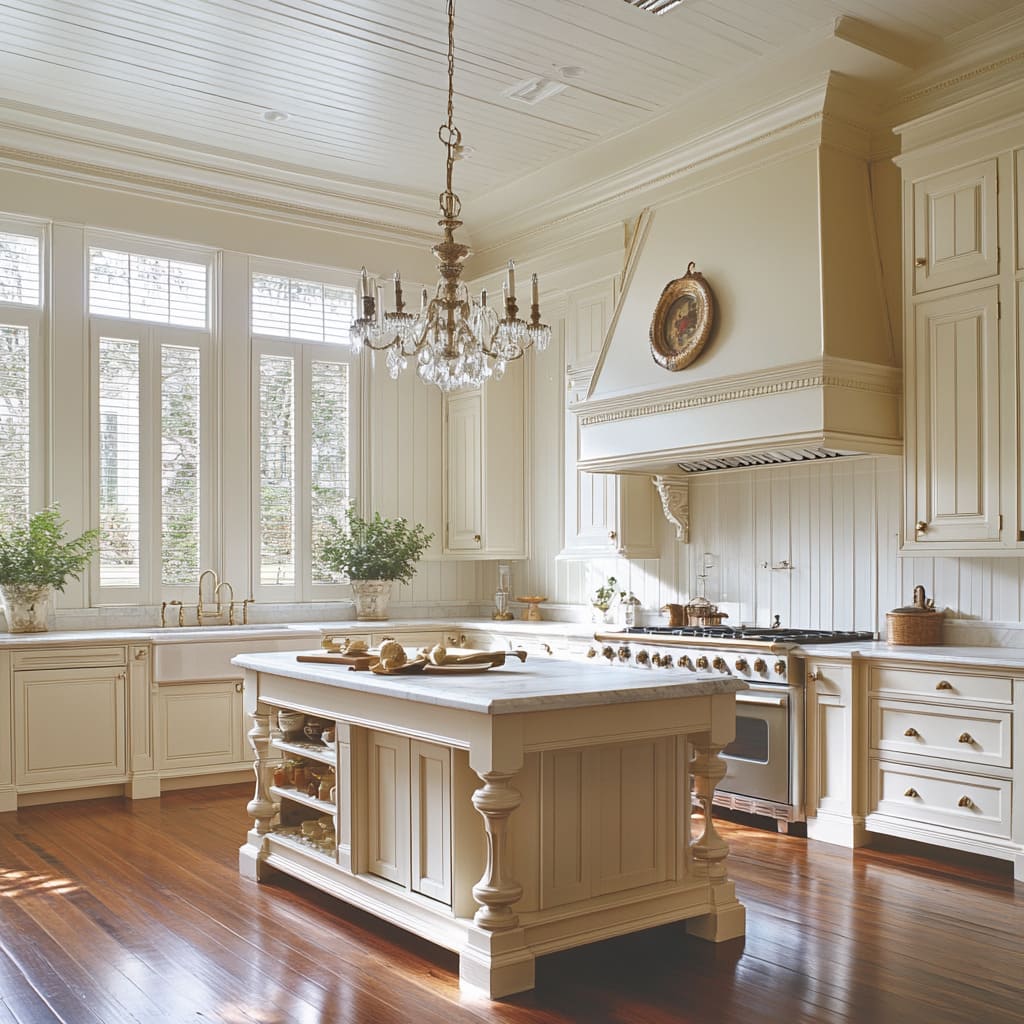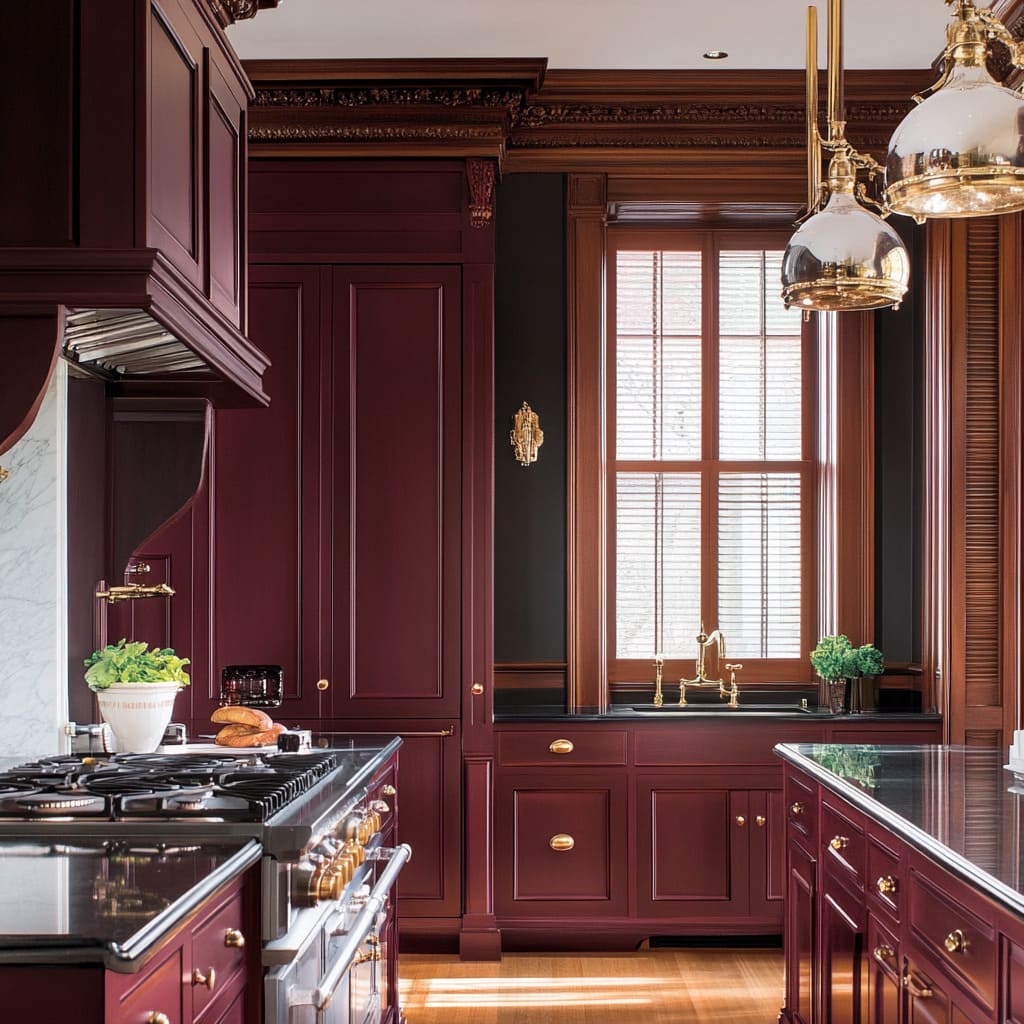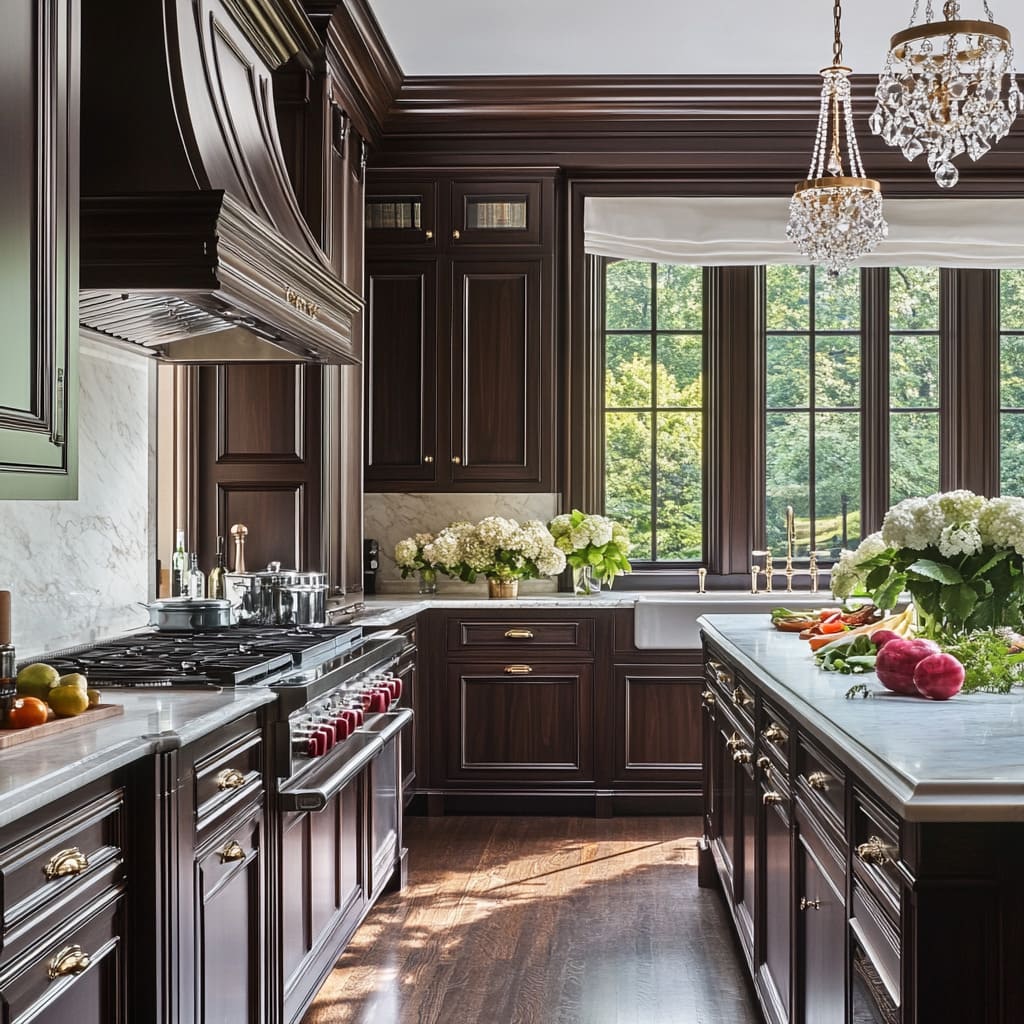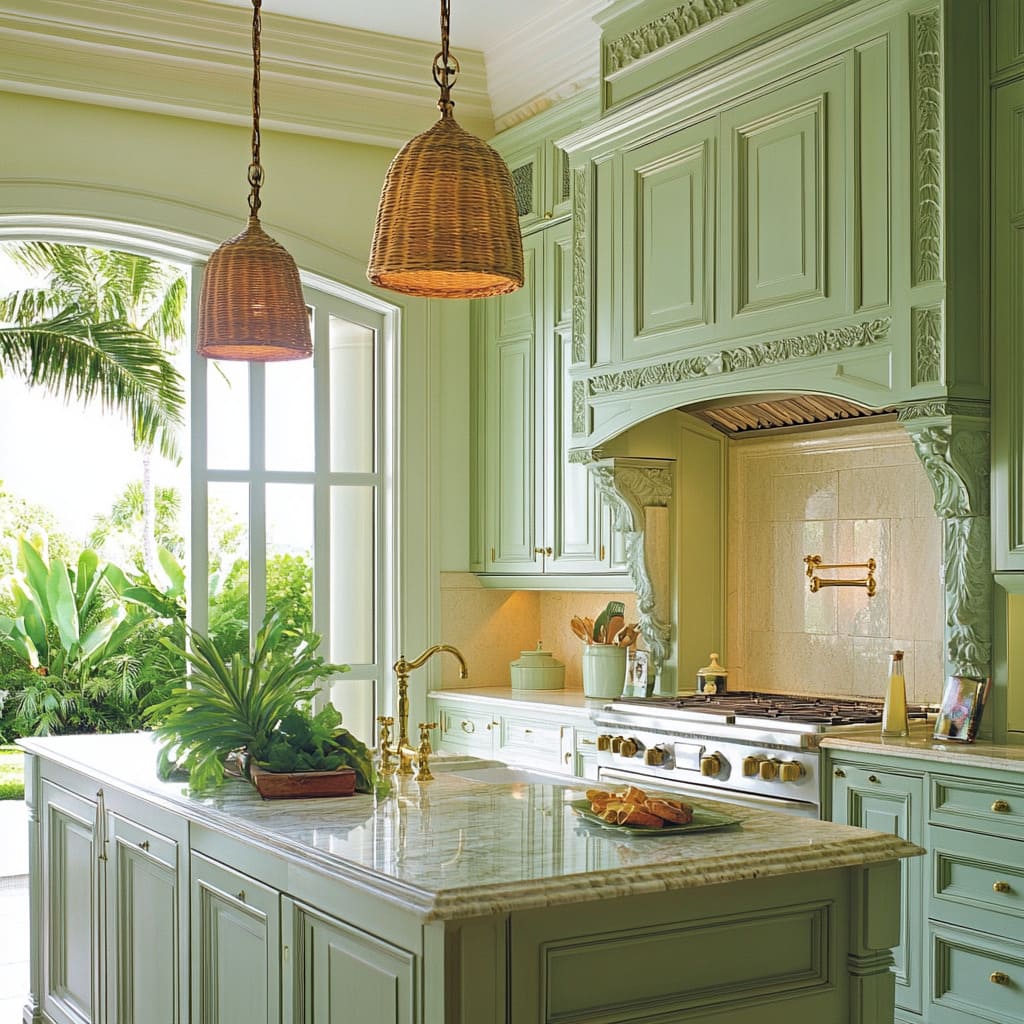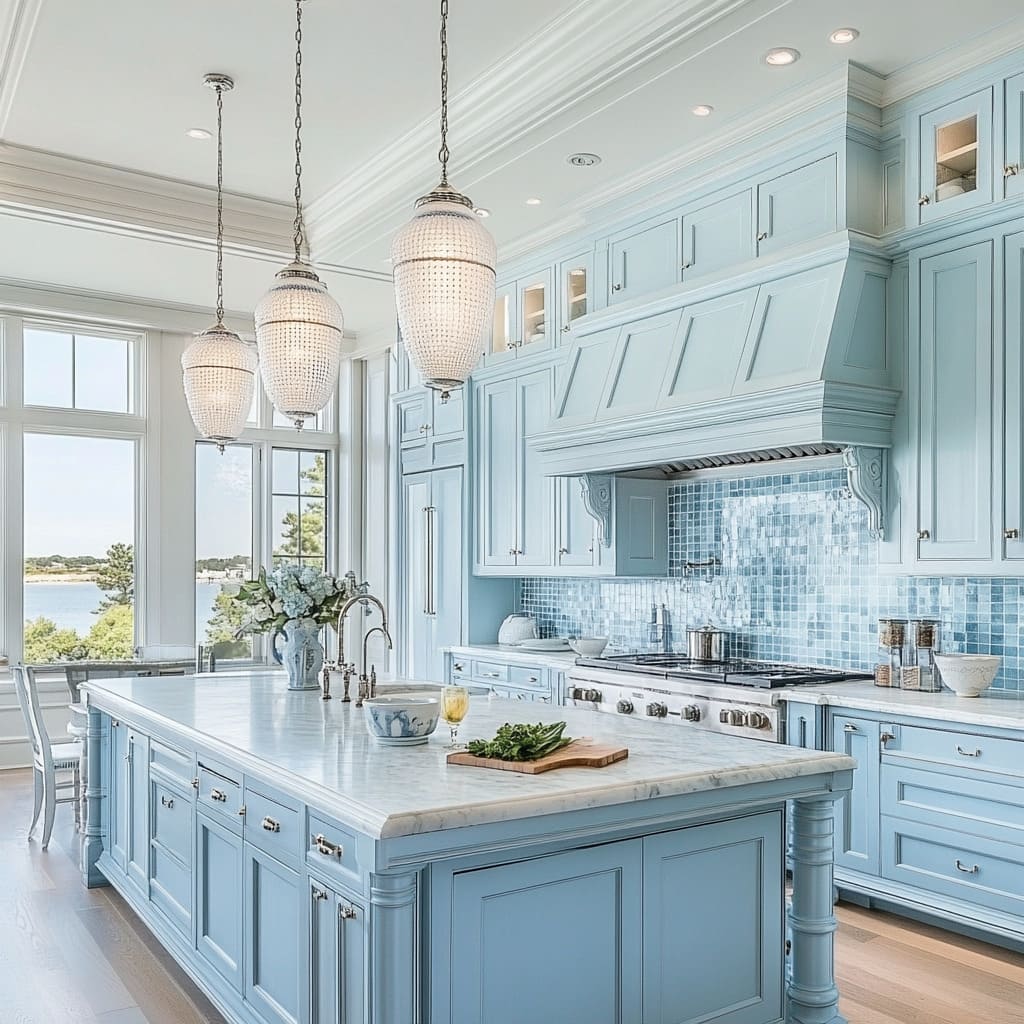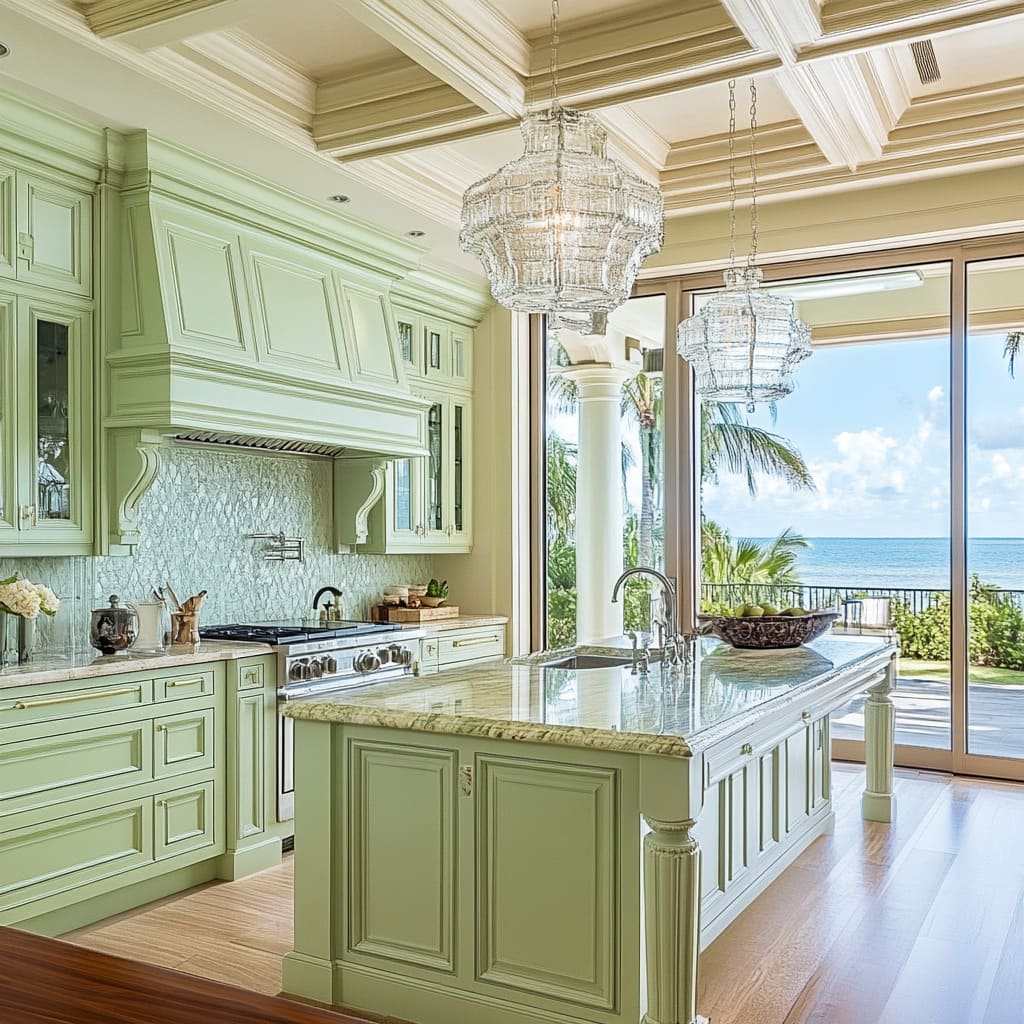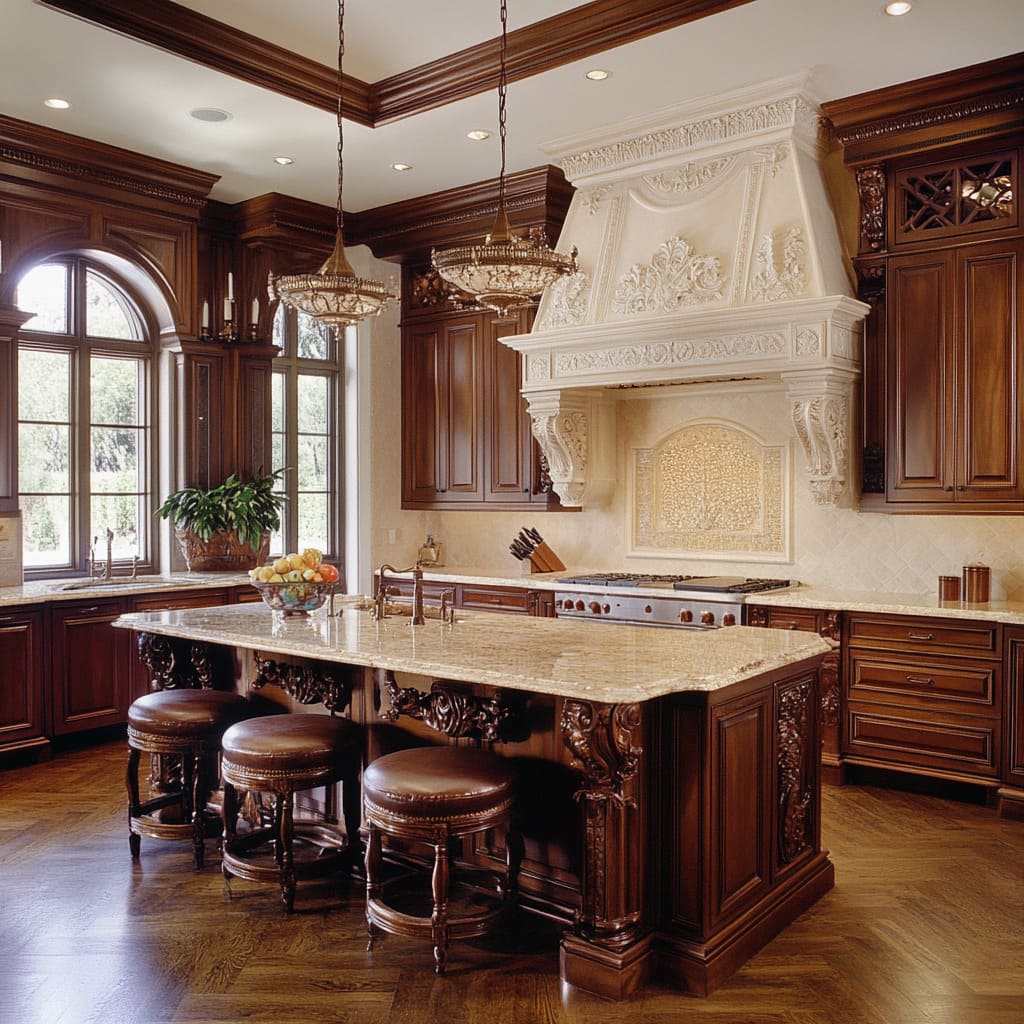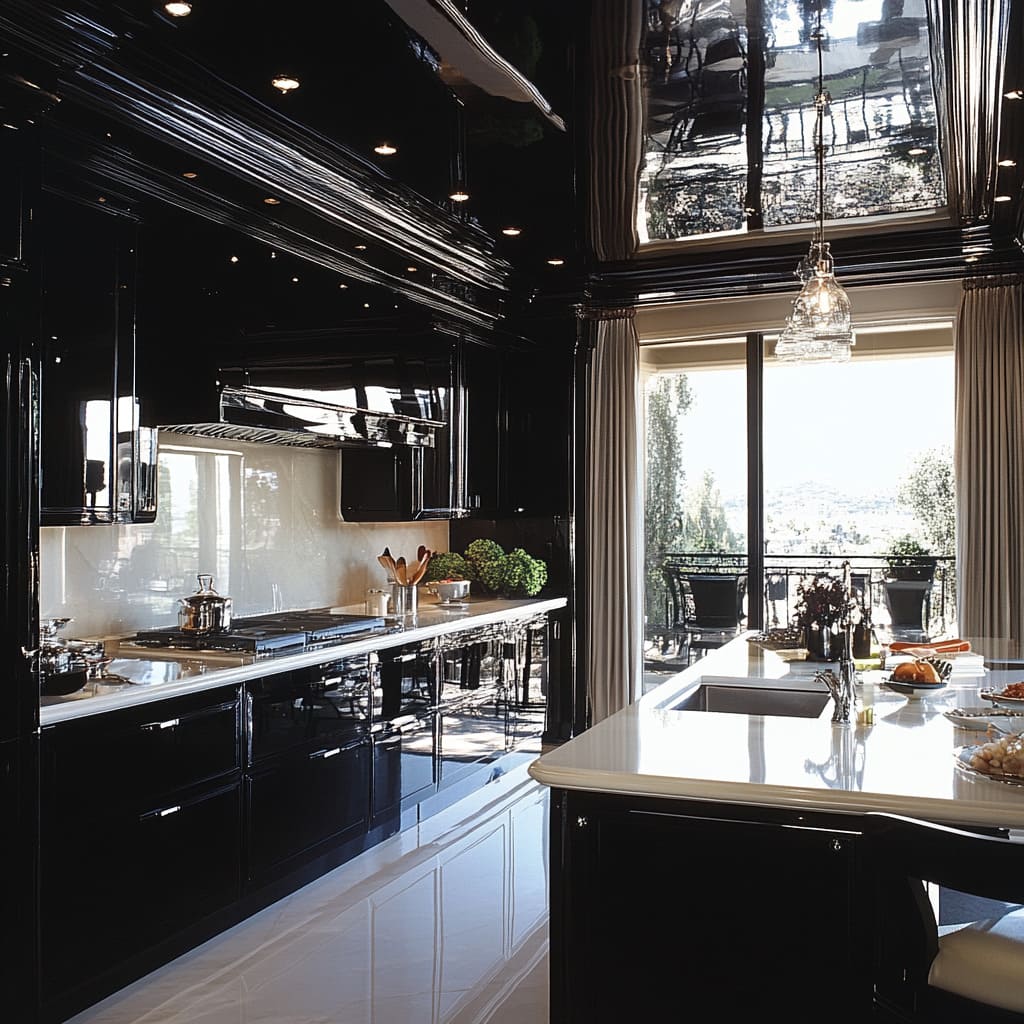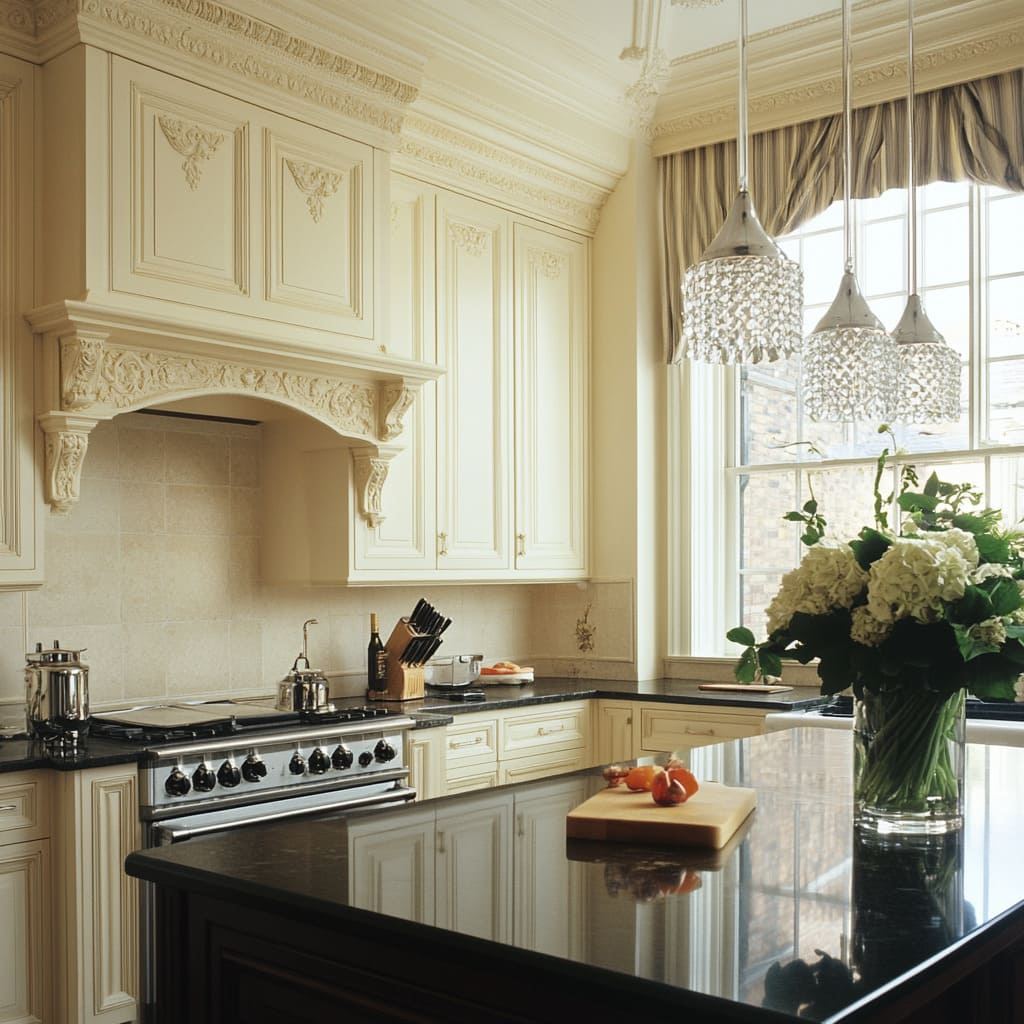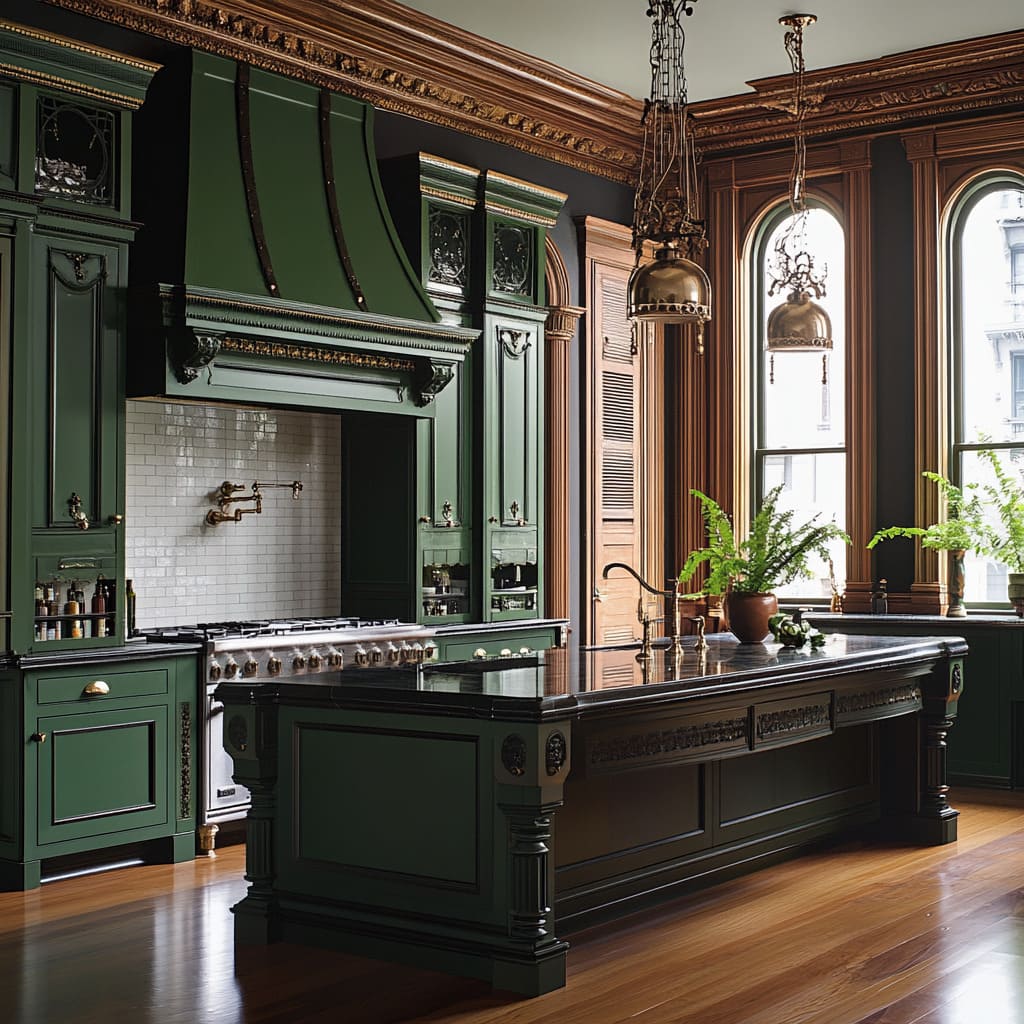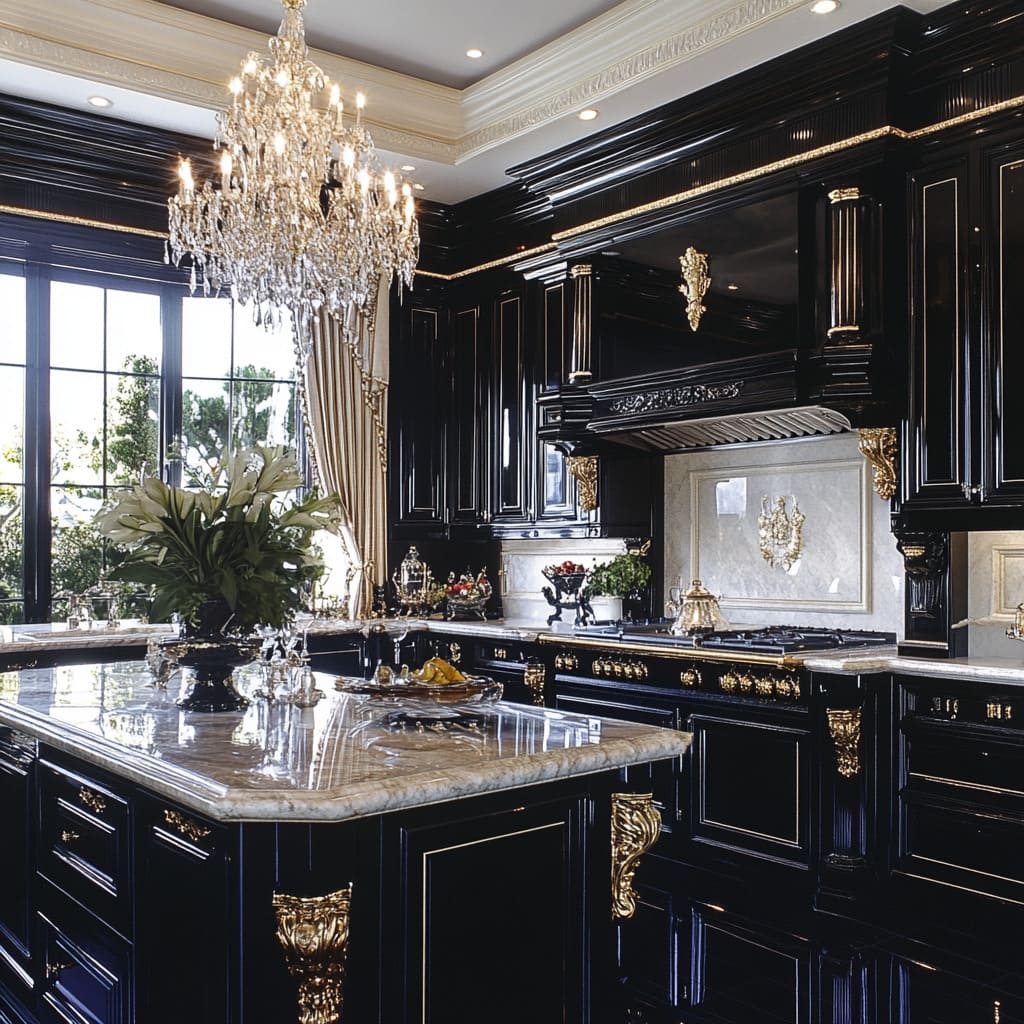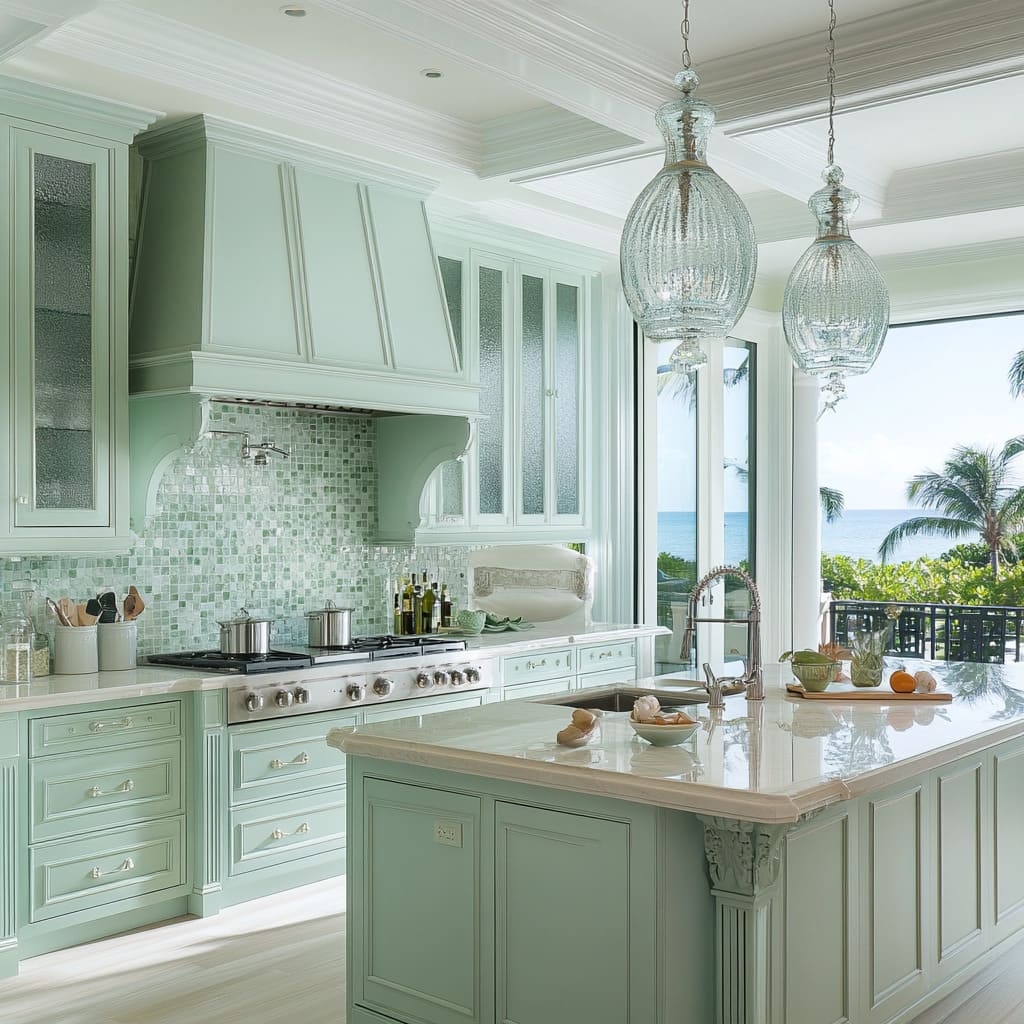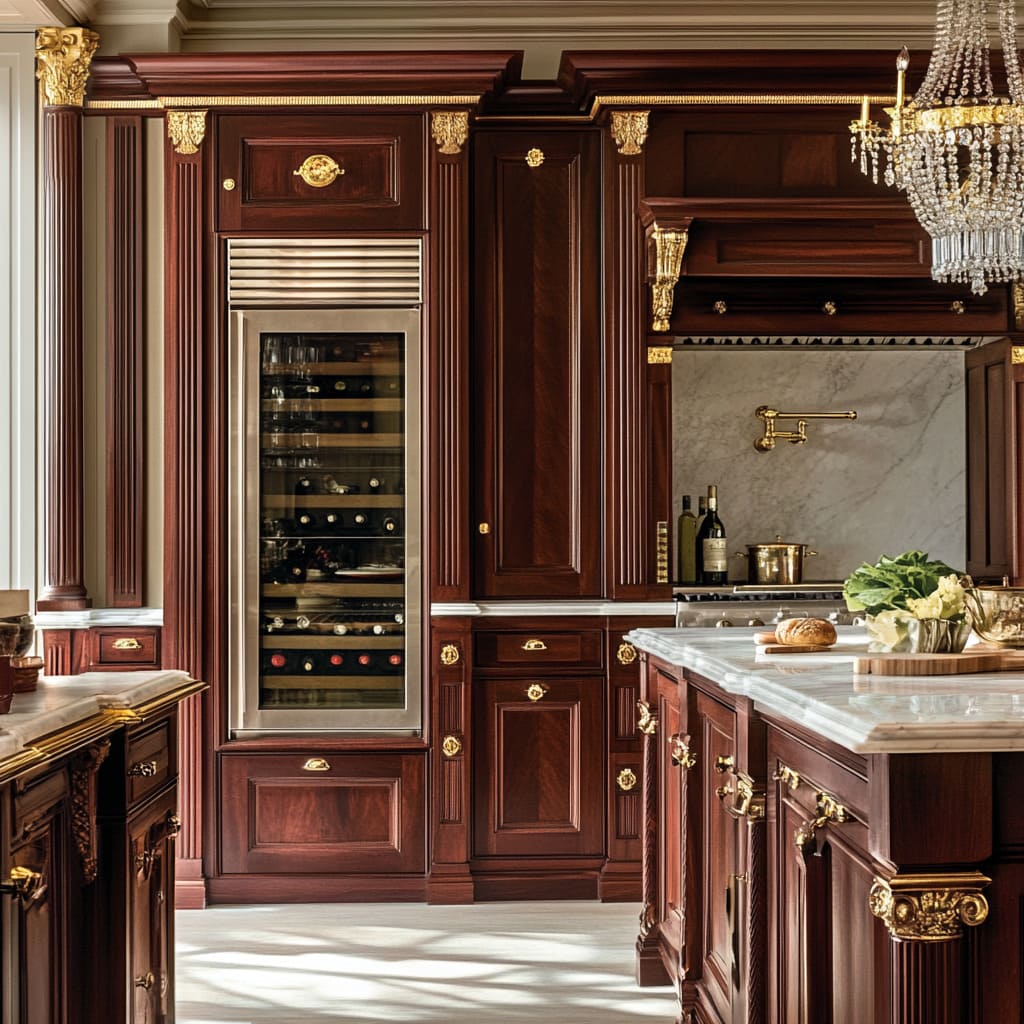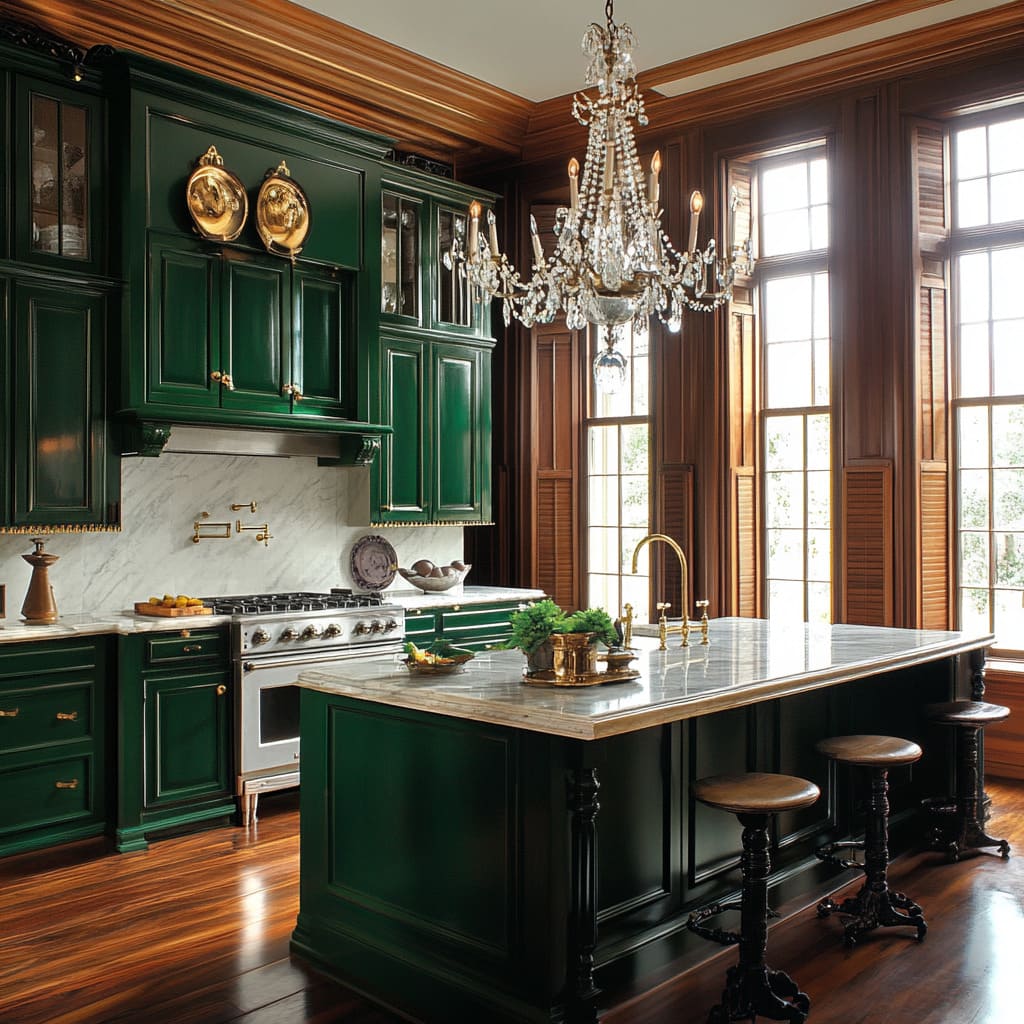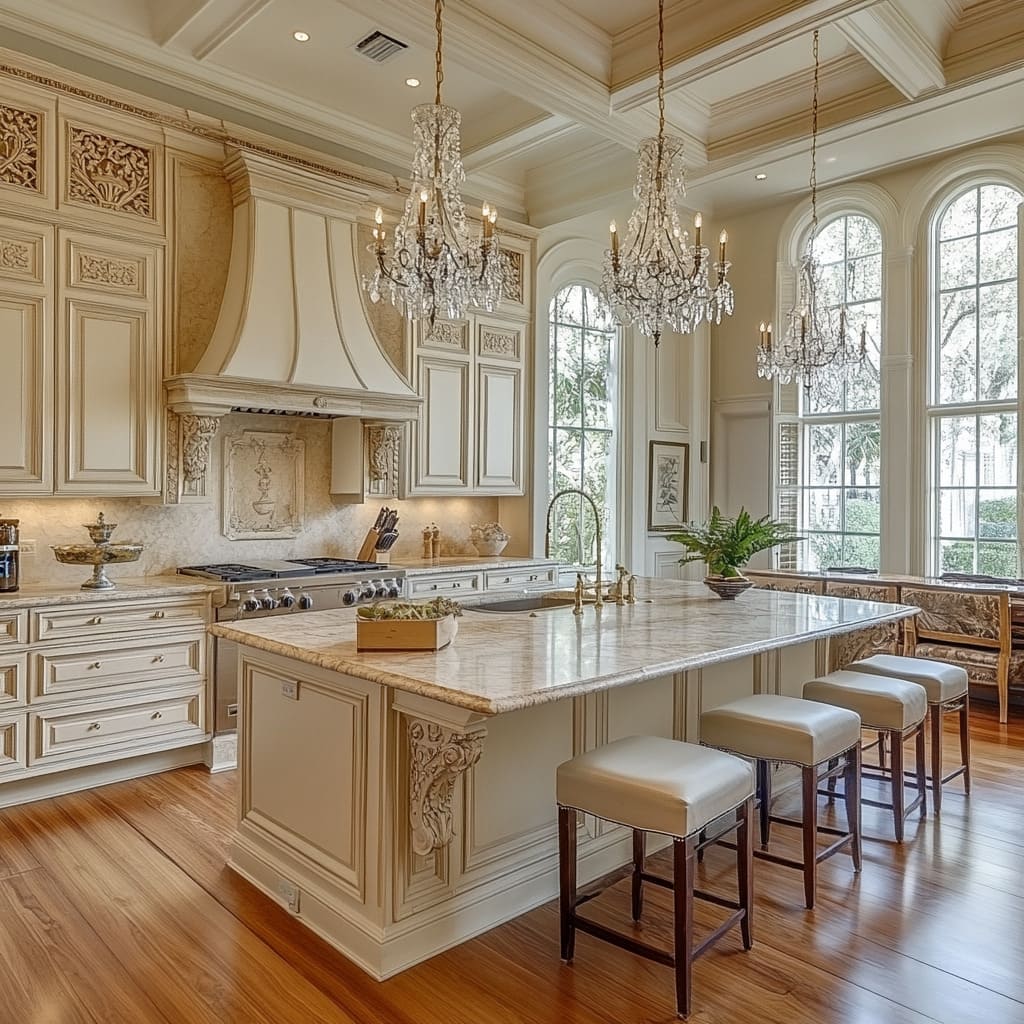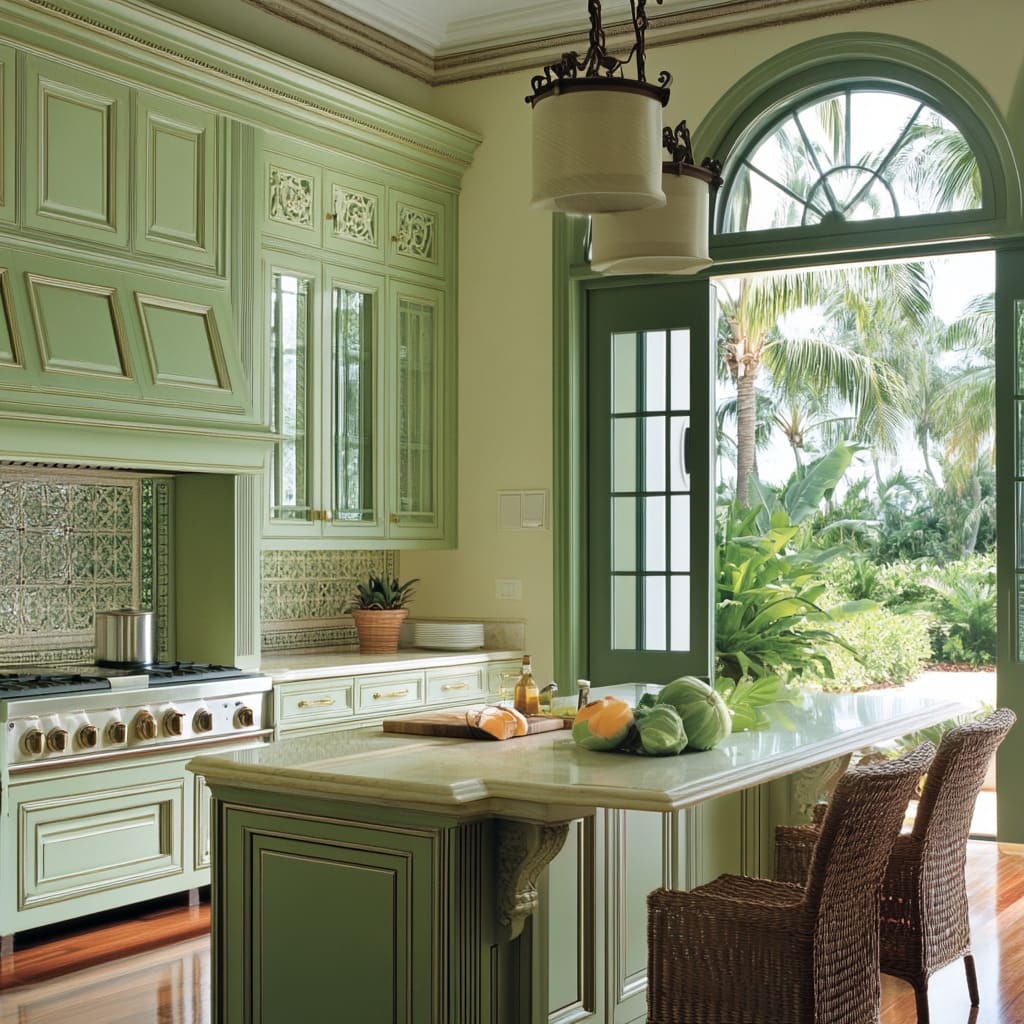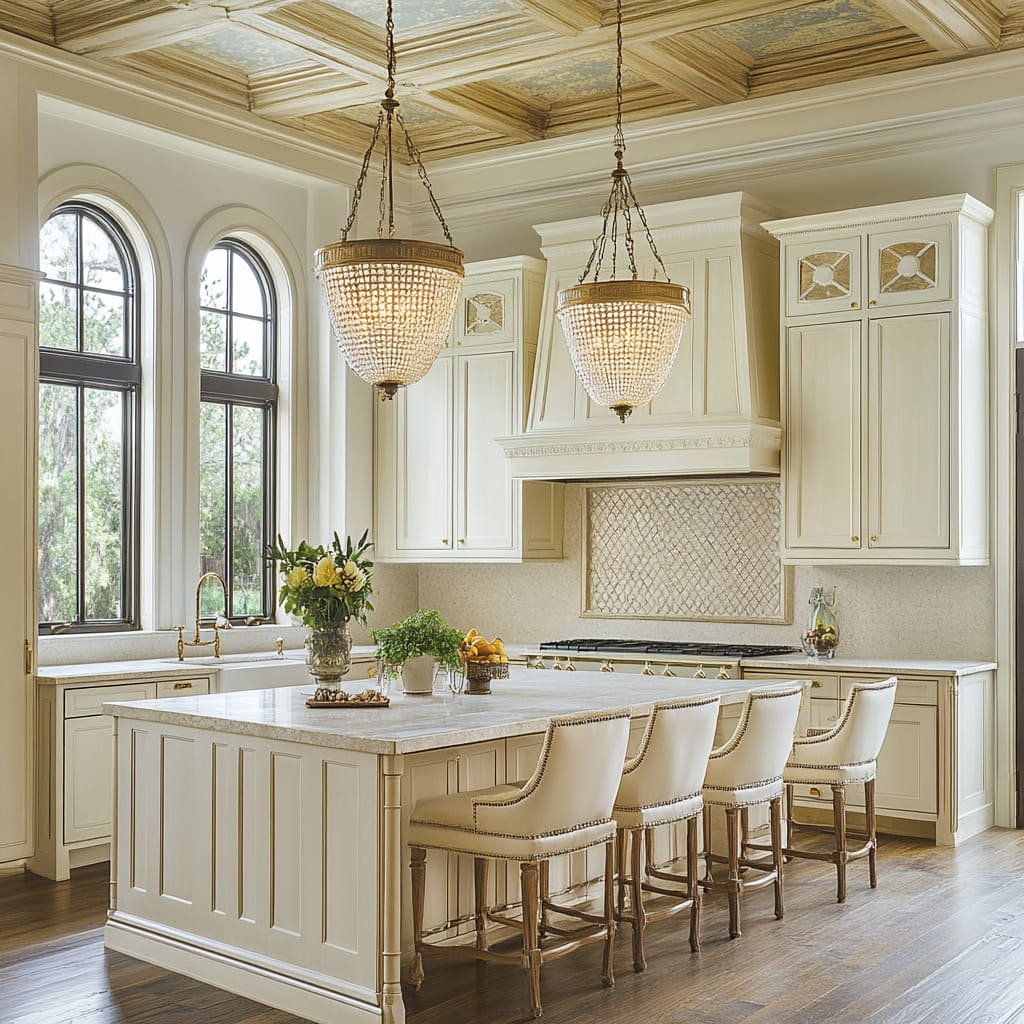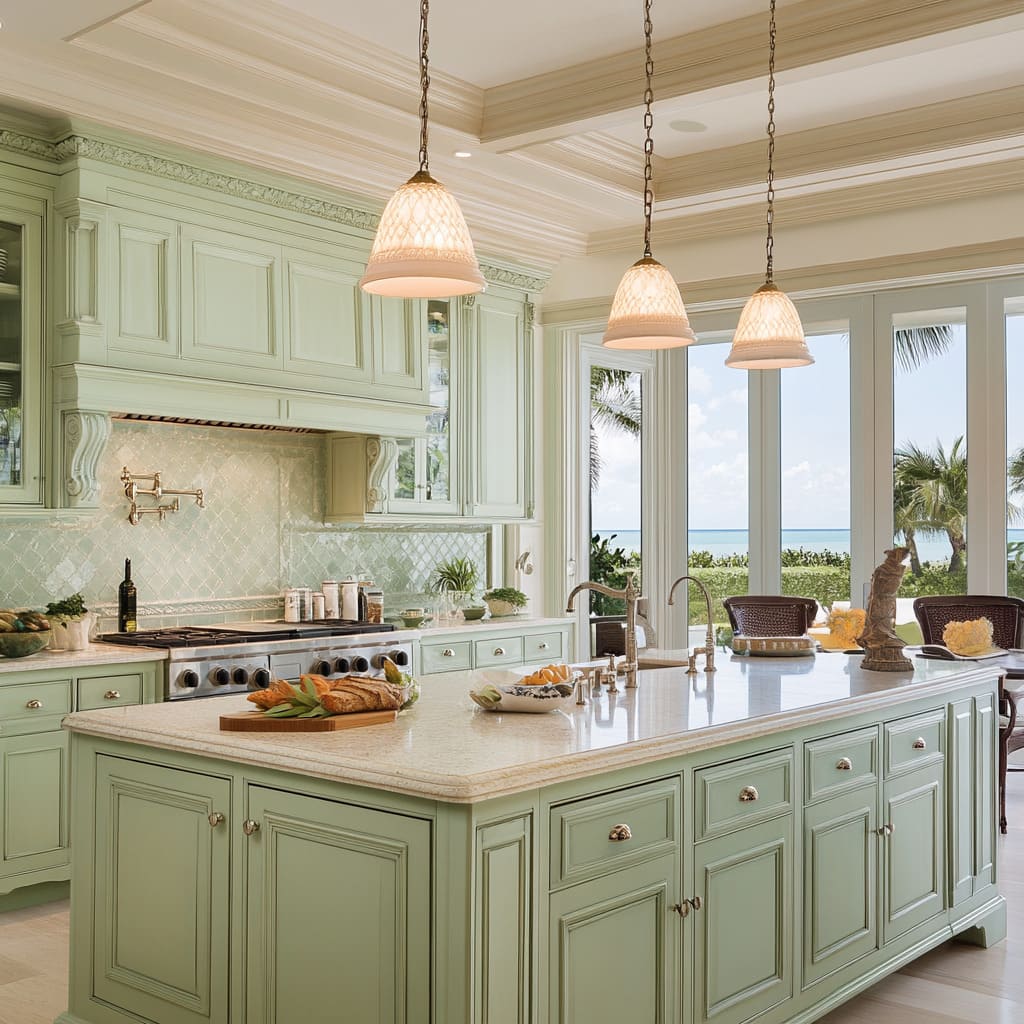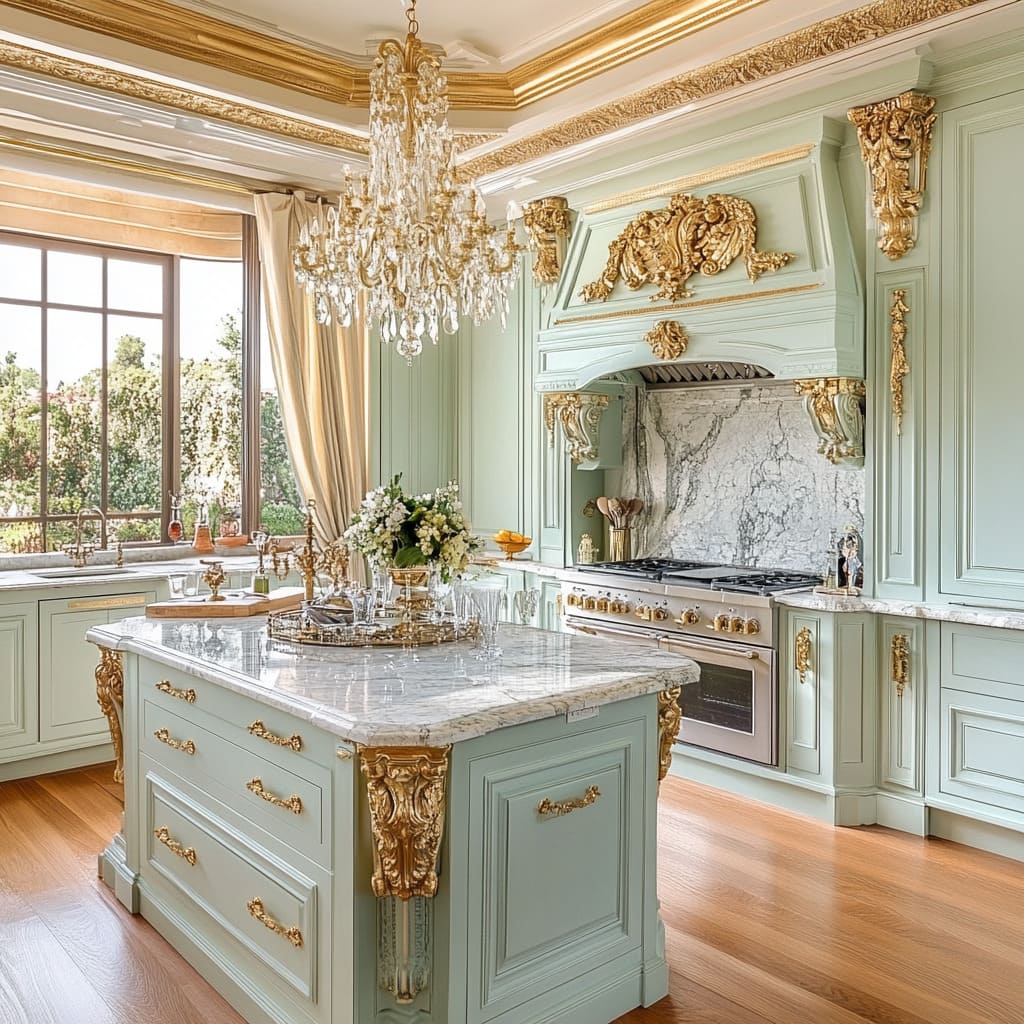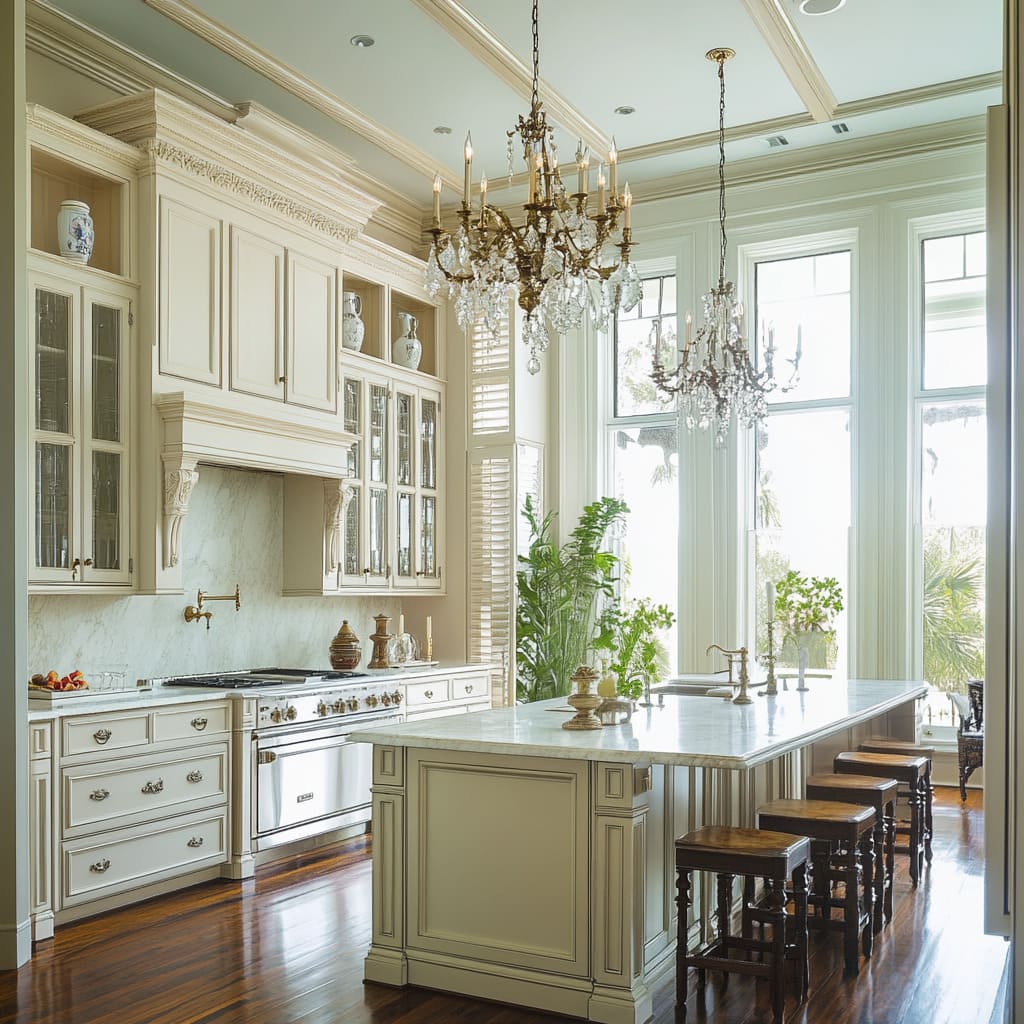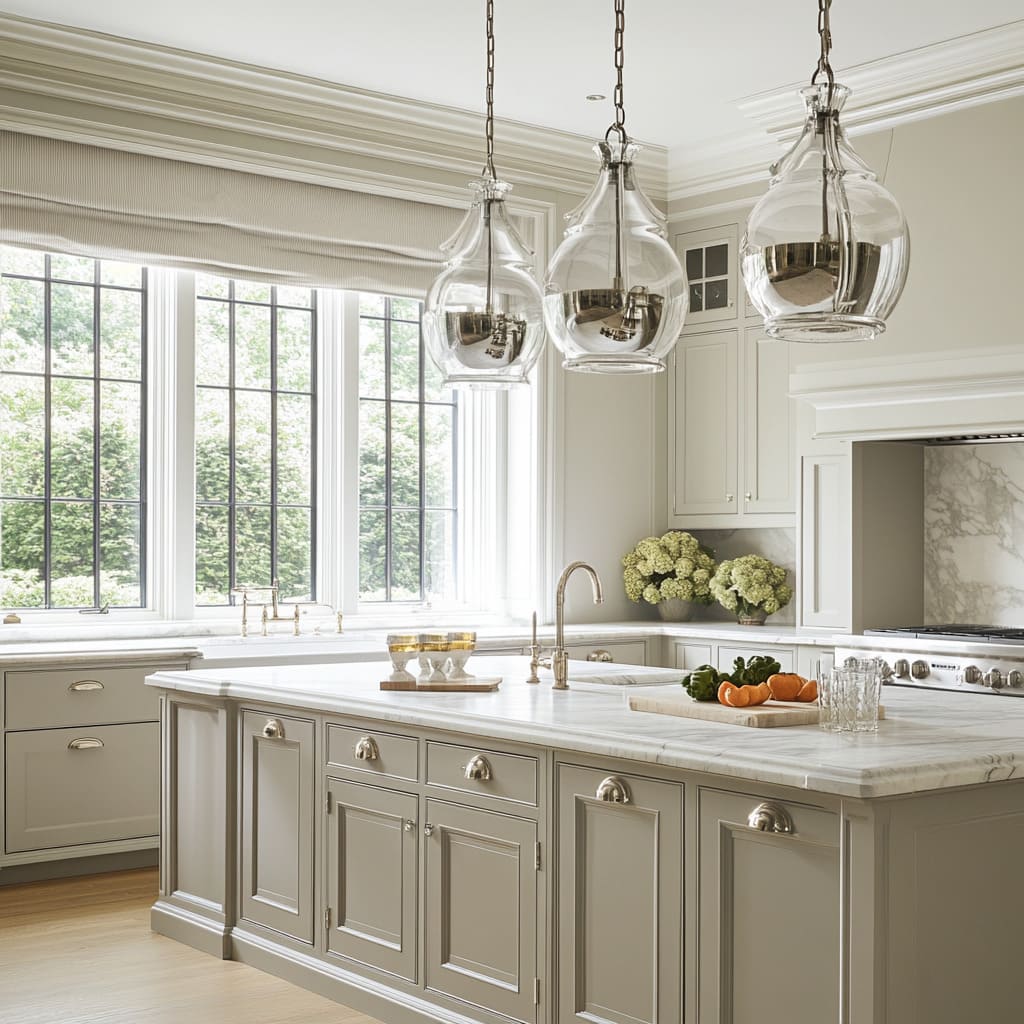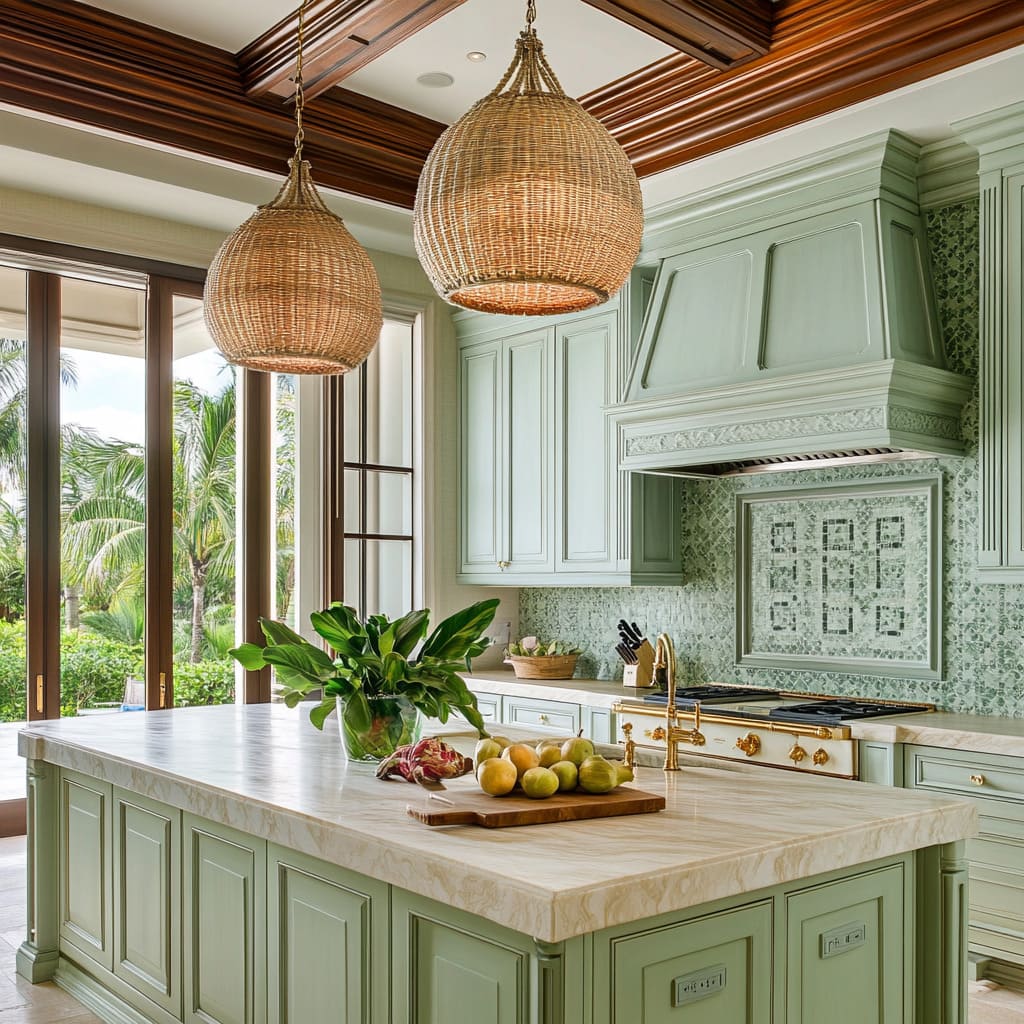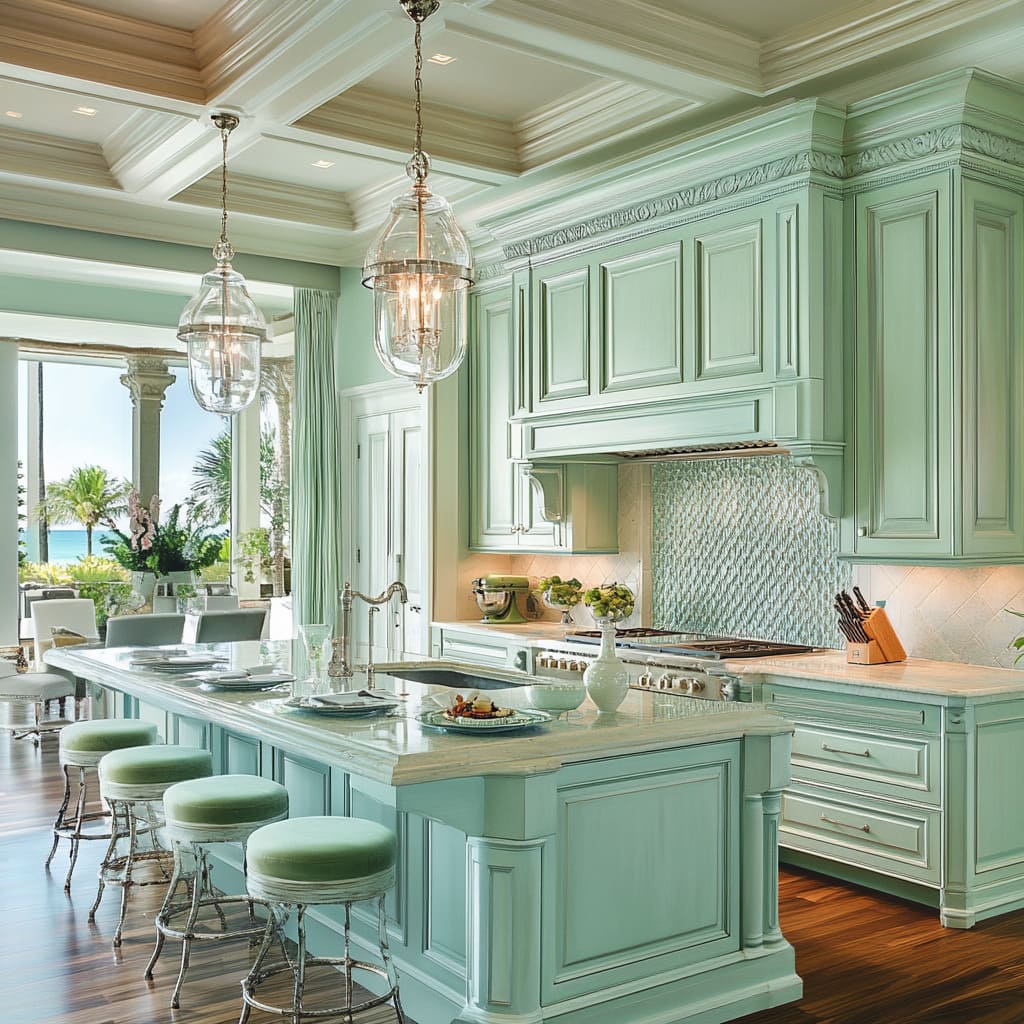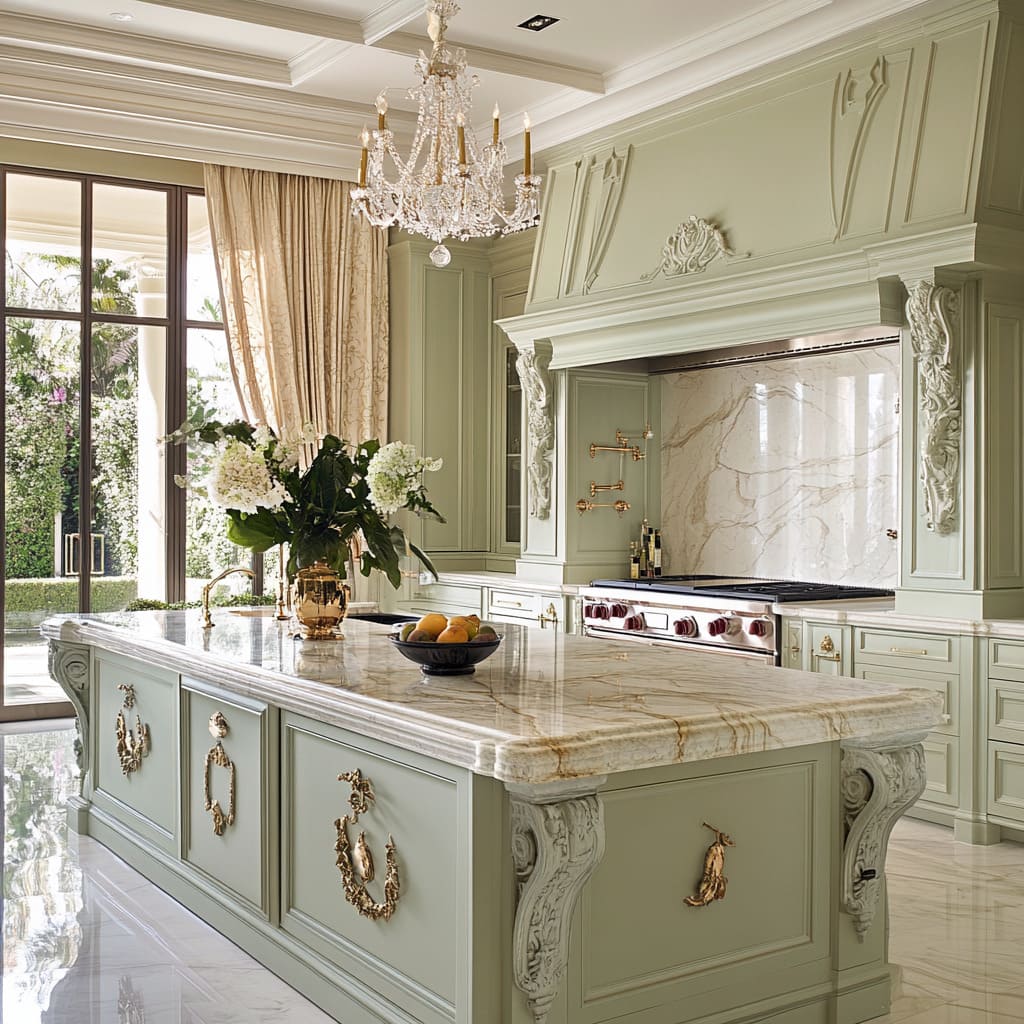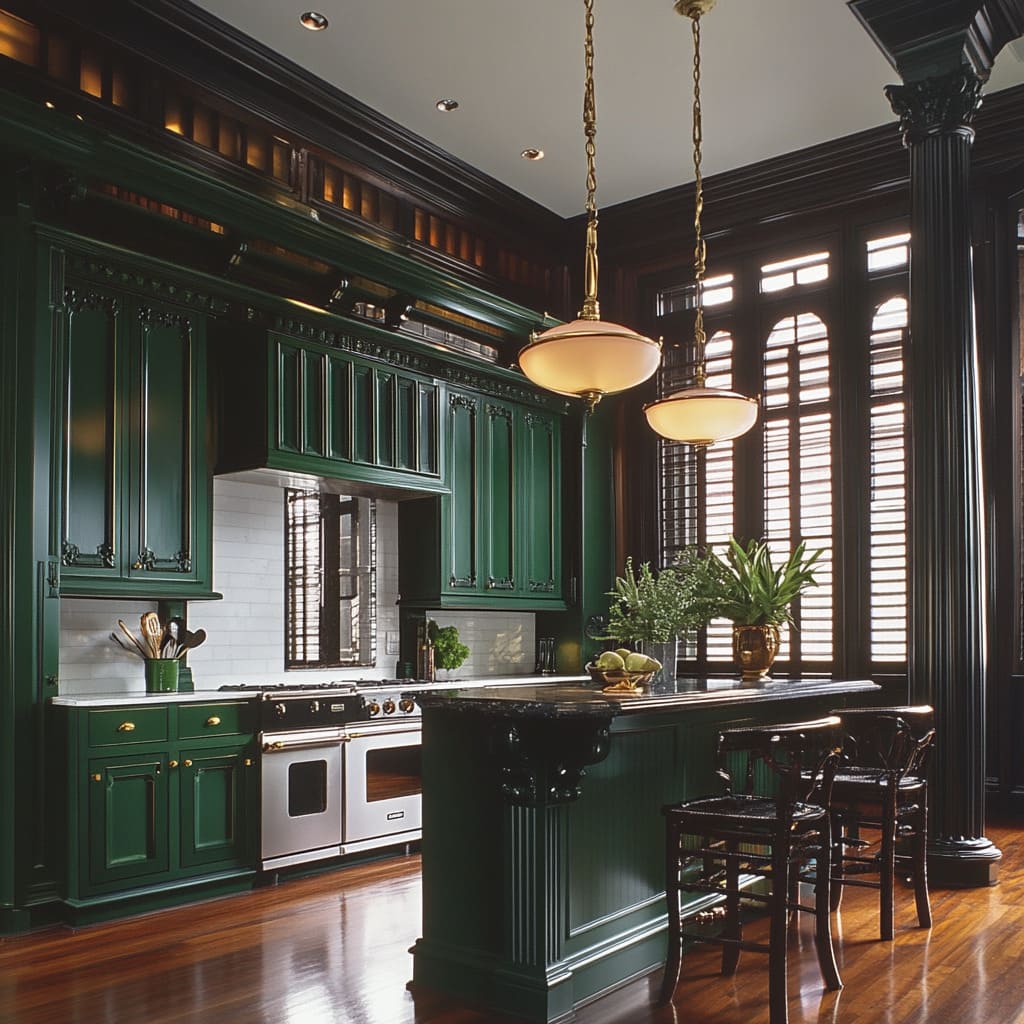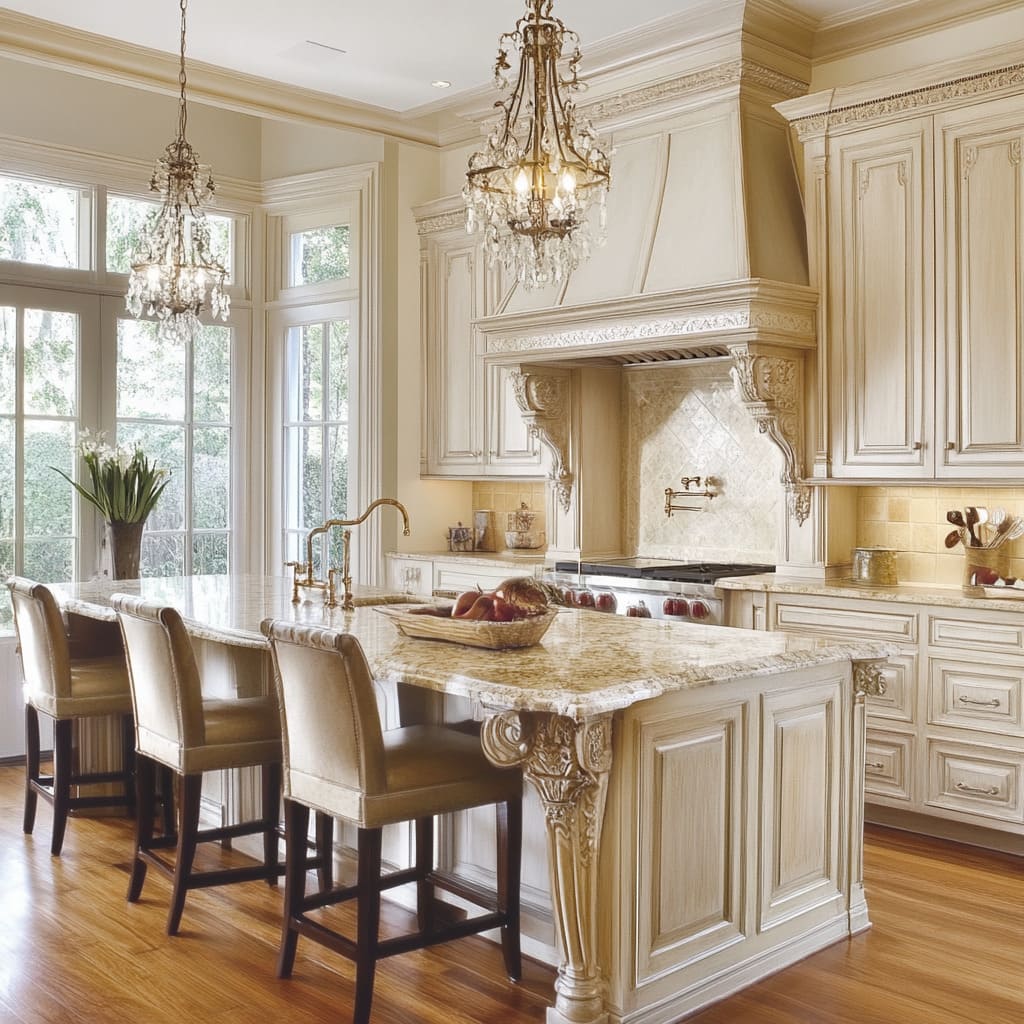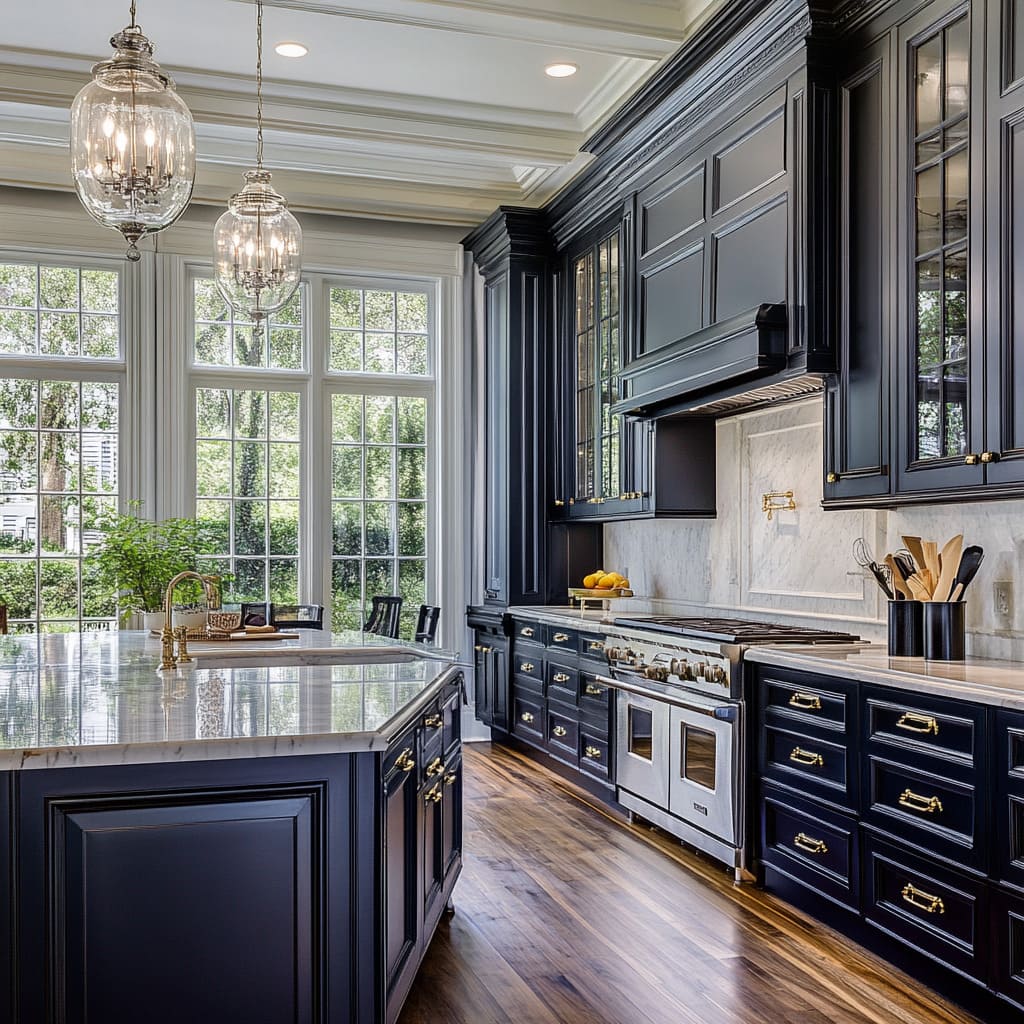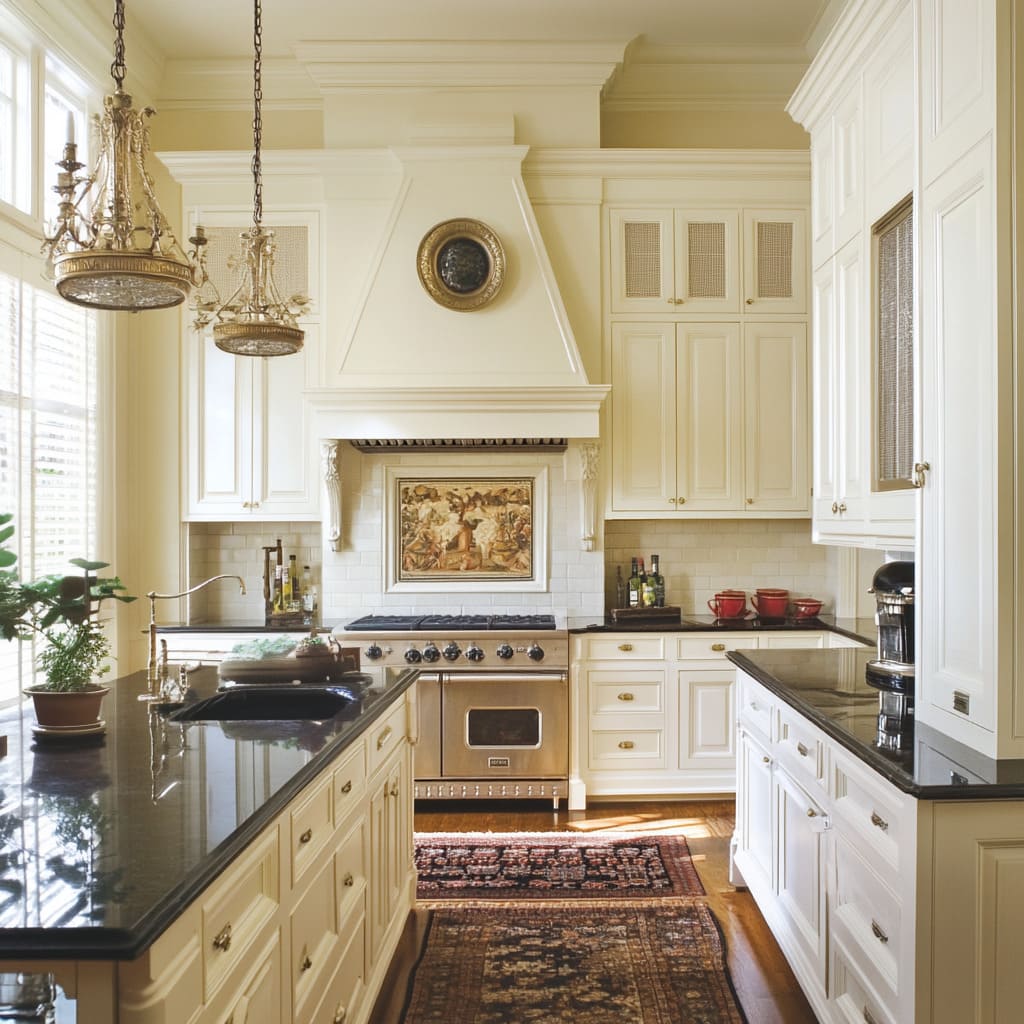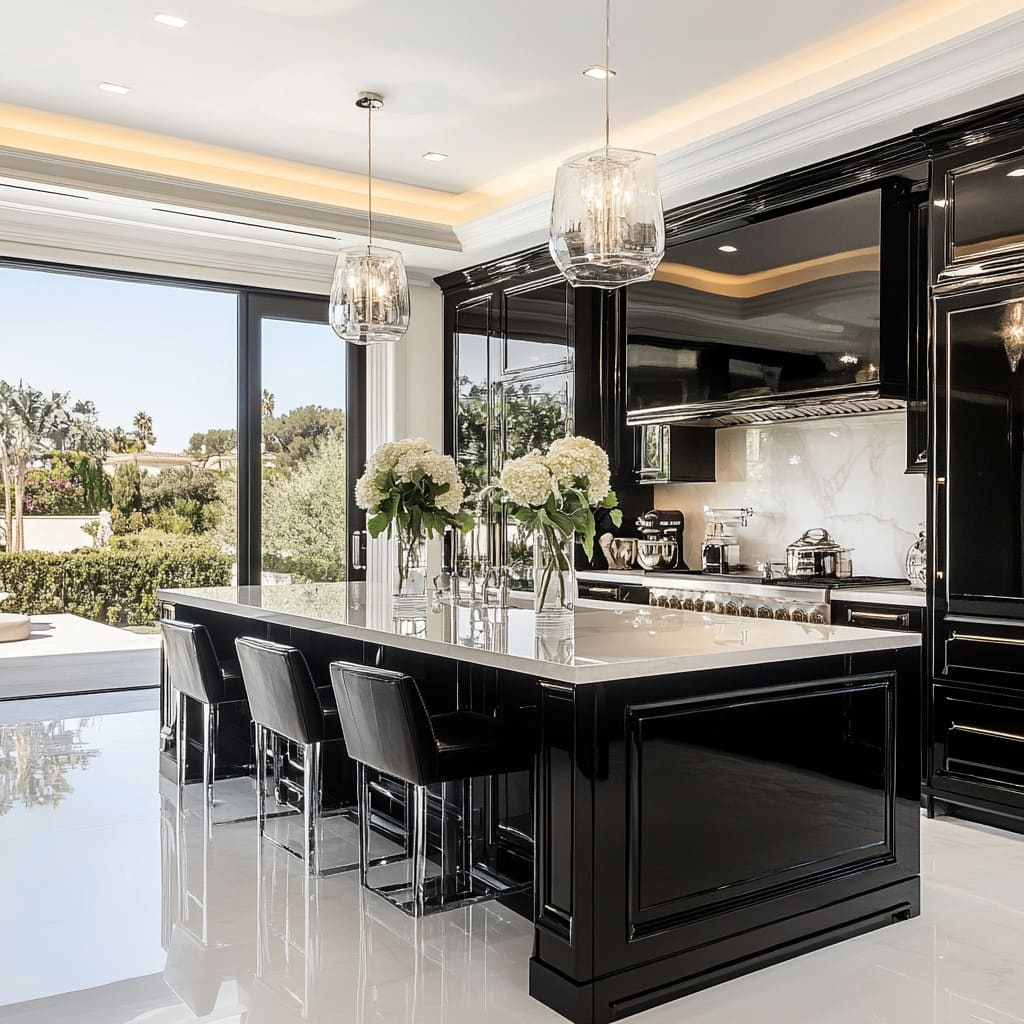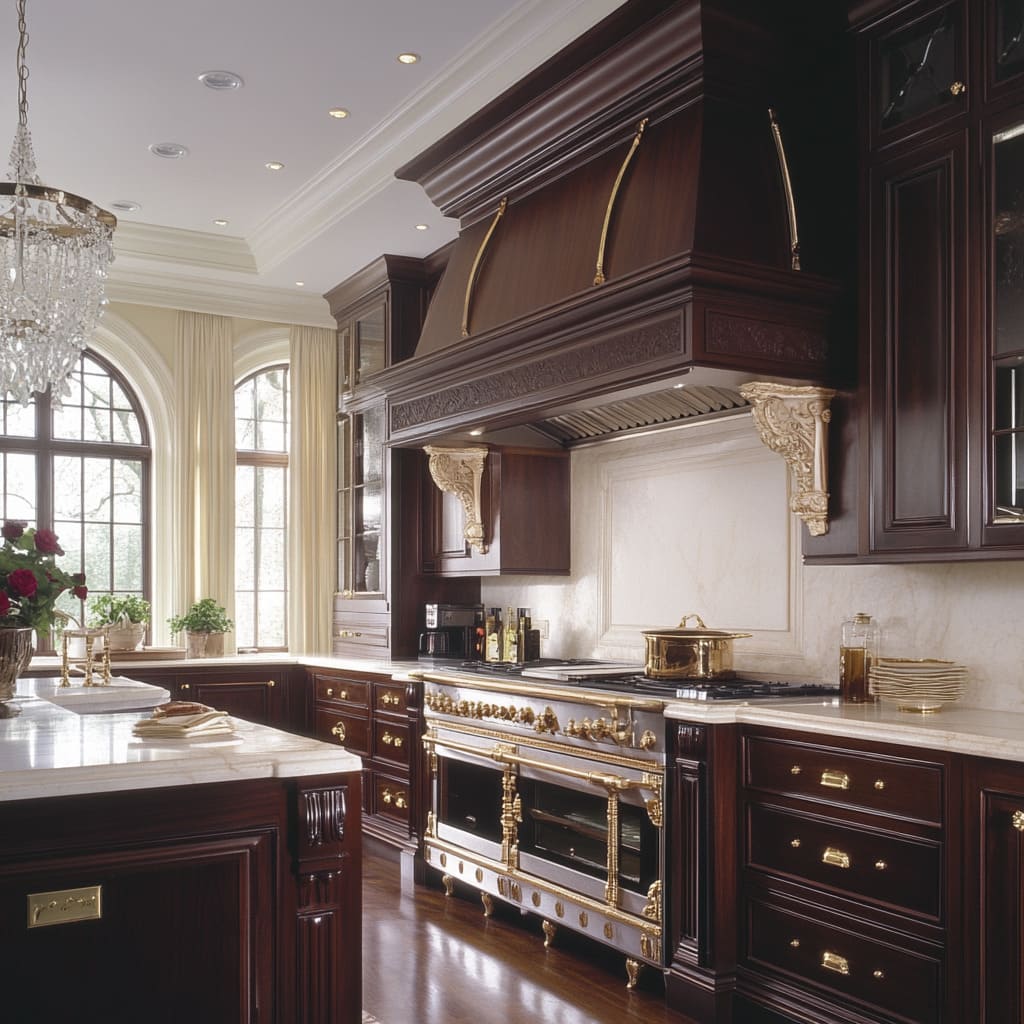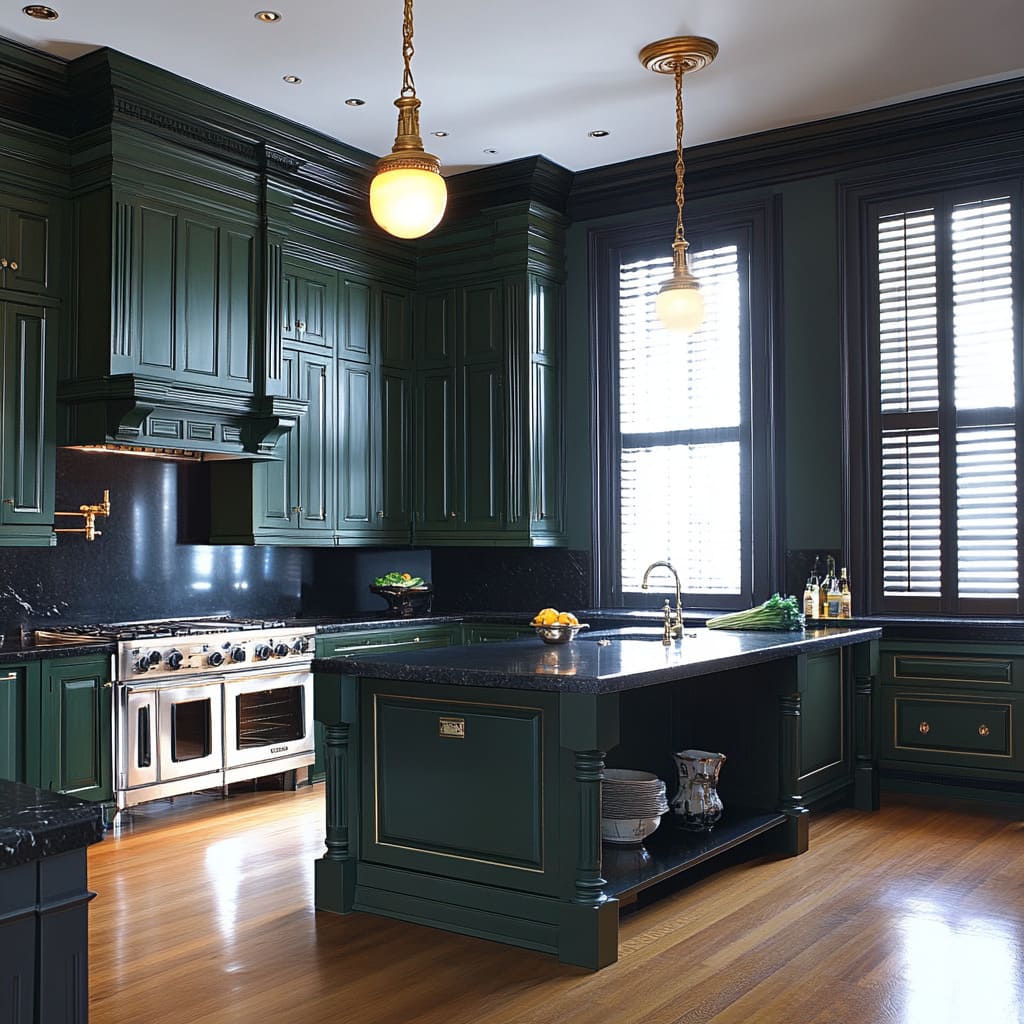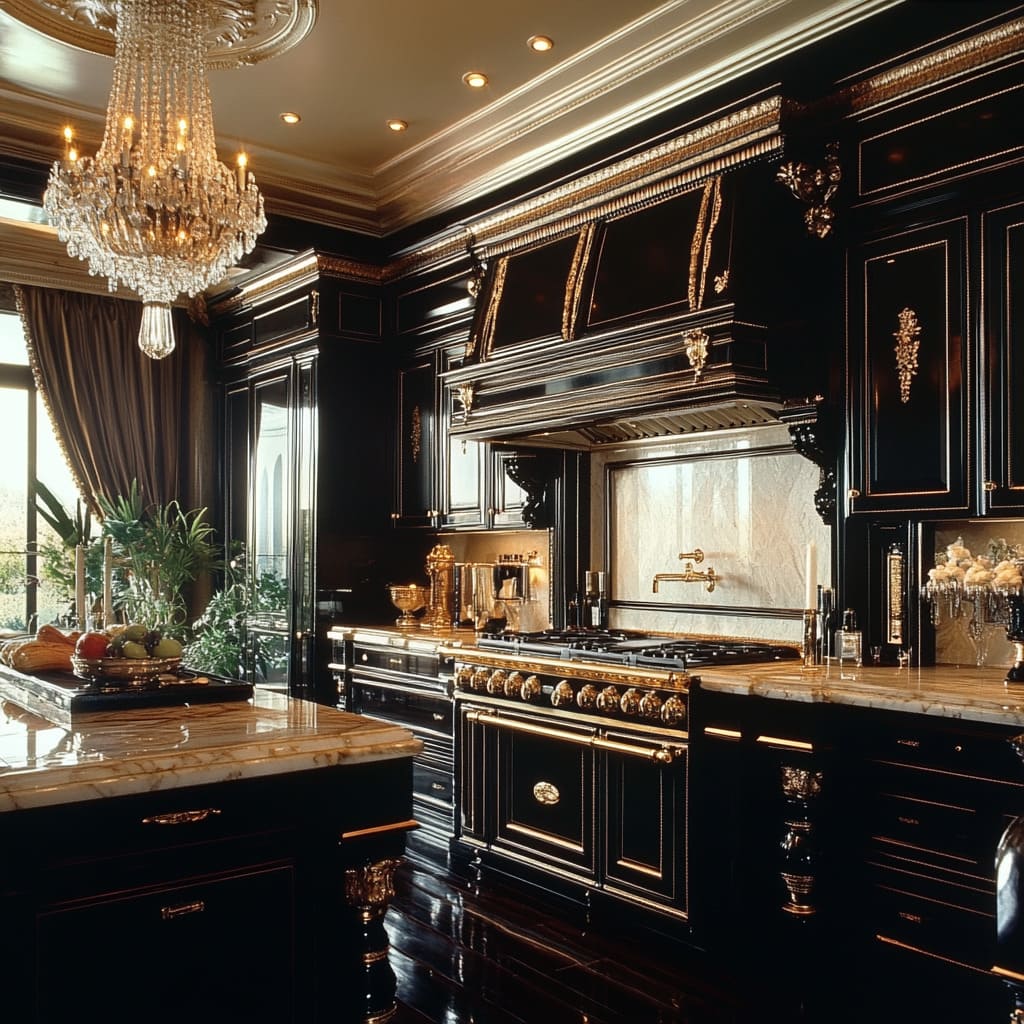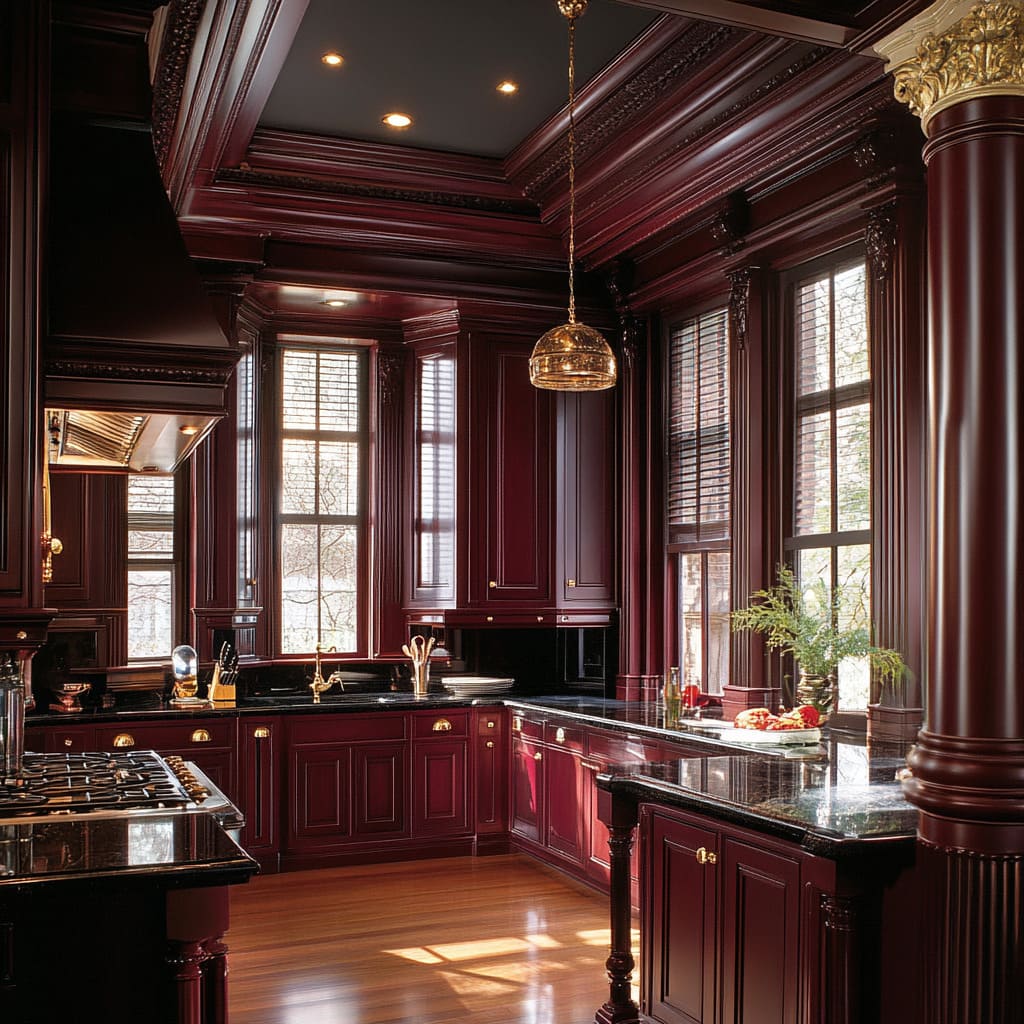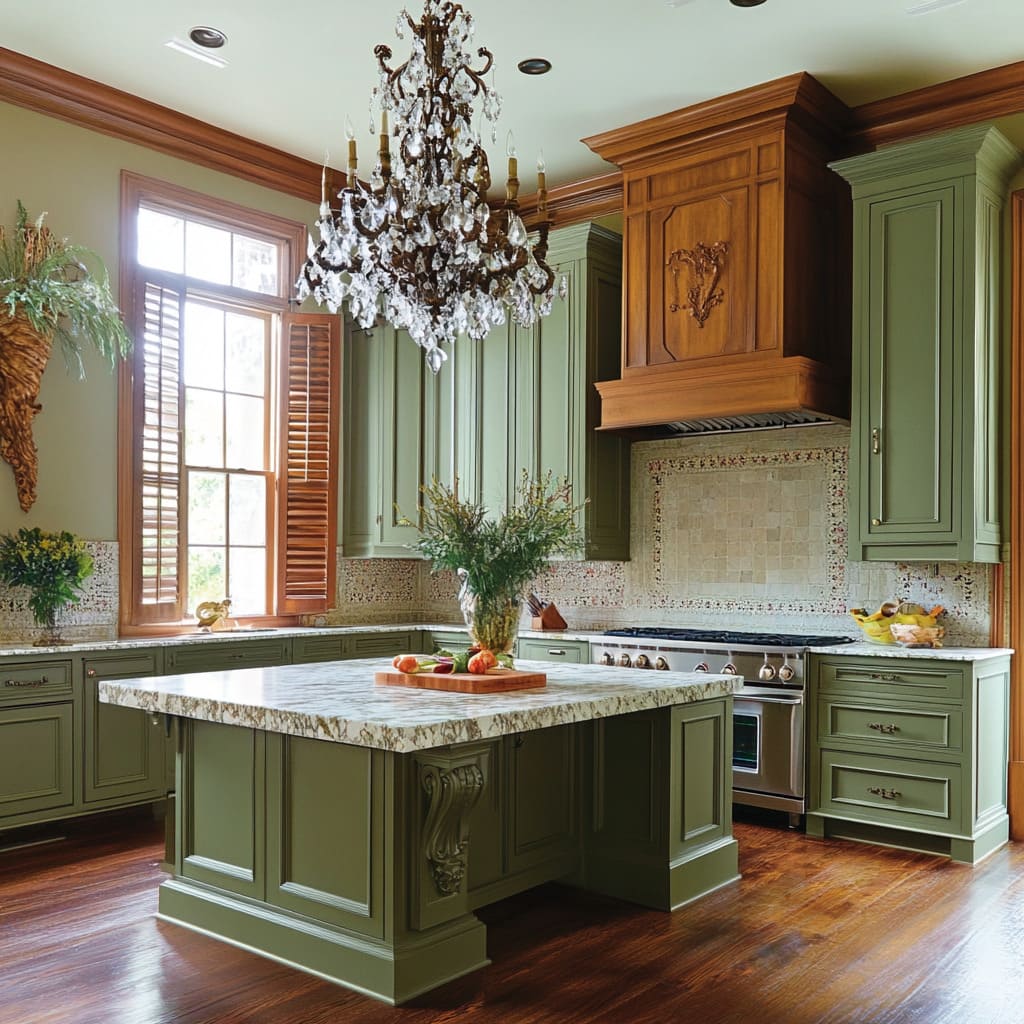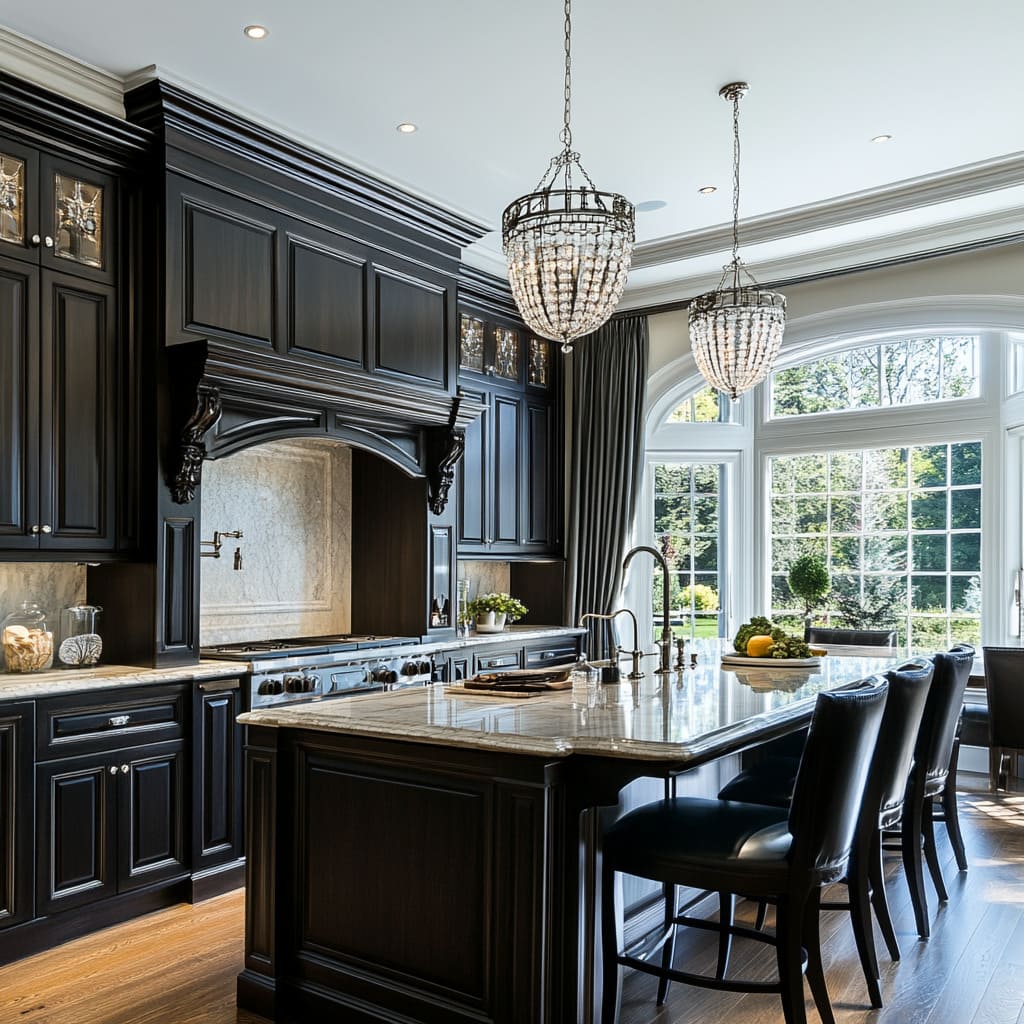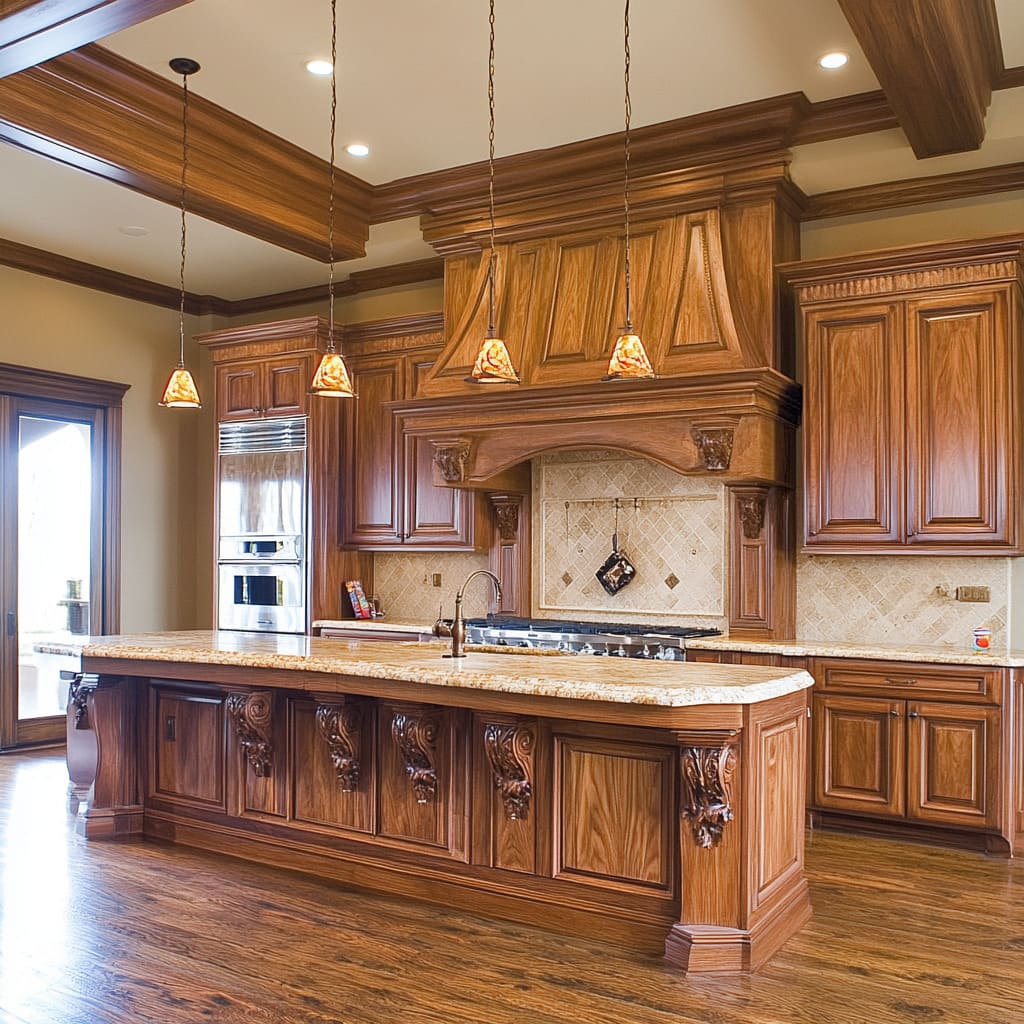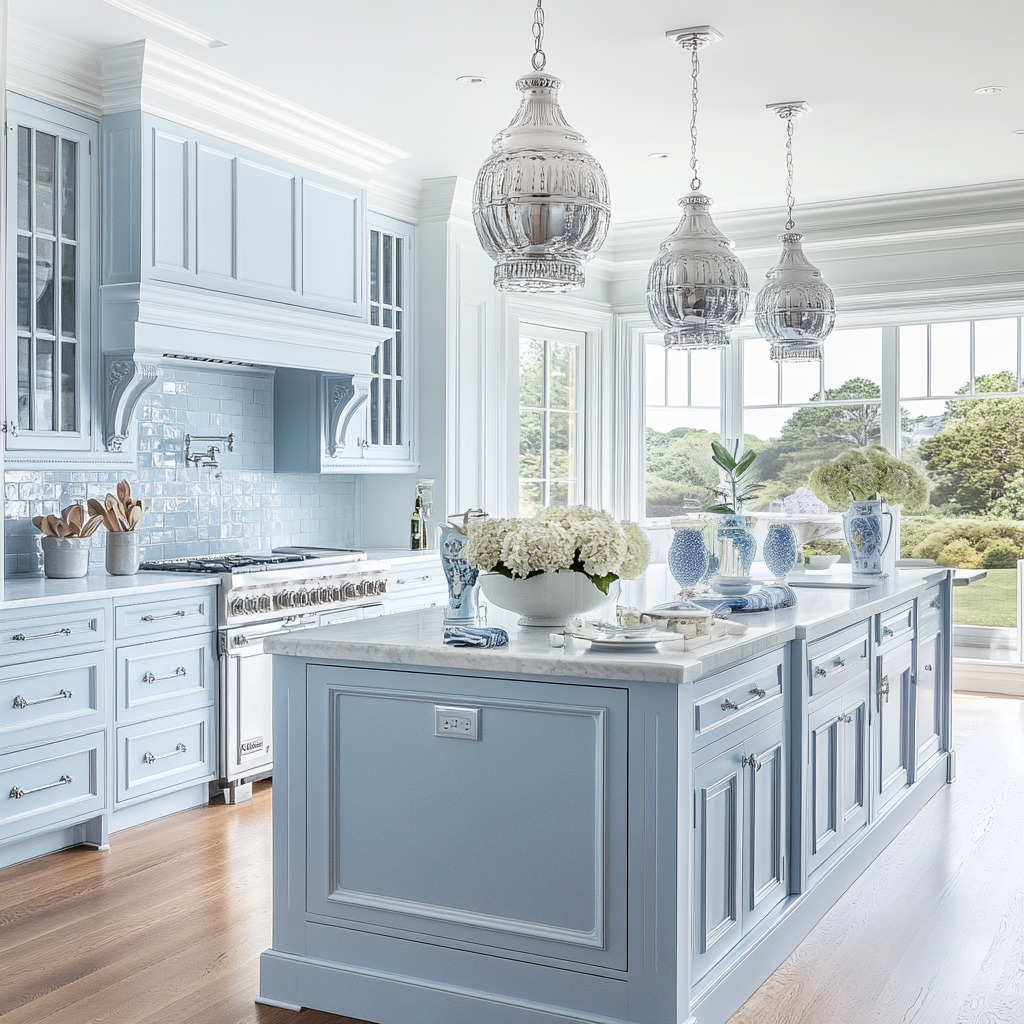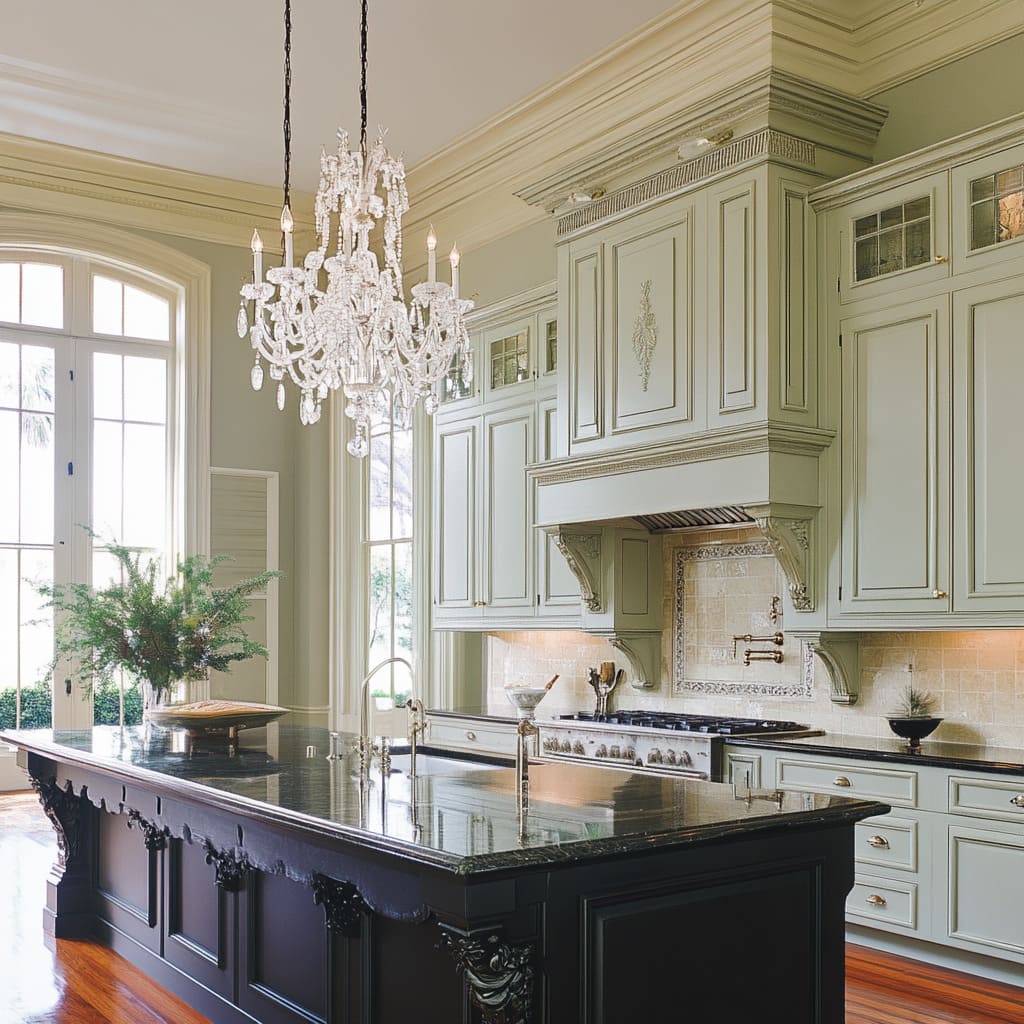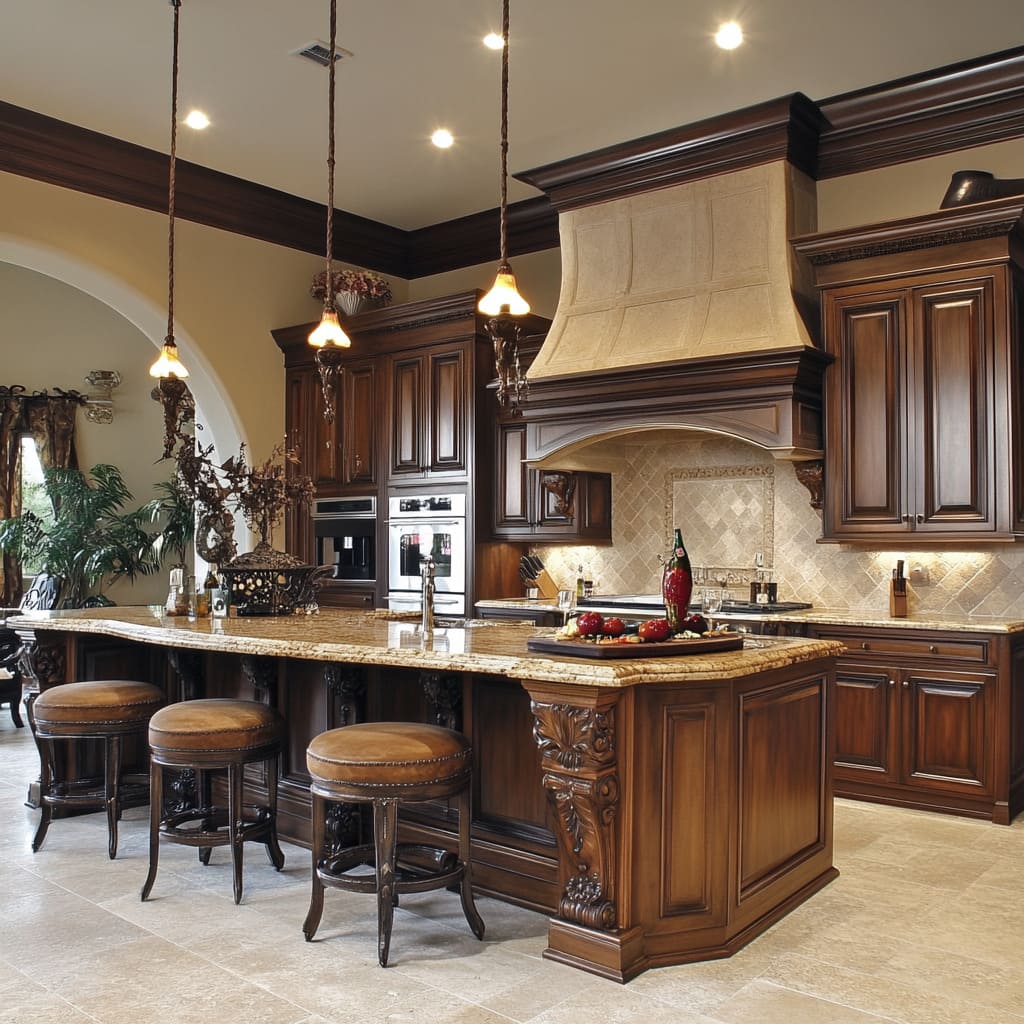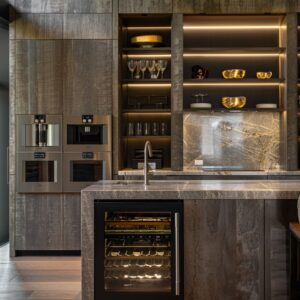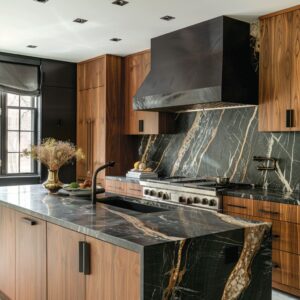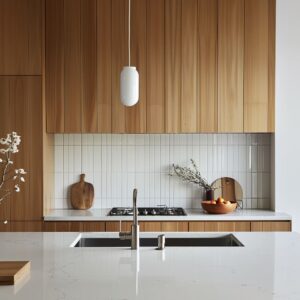Grand kitchen designs are a celebration of timeless elegance, where the charm of classic kitchen design meets the needs of modern living. These kitchens evoke a sense of history and craftsmanship while seamlessly integrating contemporary elements that cater to the demands of today’s lifestyle.
The blend of traditional aesthetics with modern functionality creates a space that feels both luxurious and welcoming. In recent years, there has been a noticeable trend toward incorporating features like intricate moldings, high ceilings, and luxurious materials such as marble and hardwood into kitchen designs that also boast state-of-the-art appliances, innovative storage solutions, and sleek finishes.
This approach ensures that these kitchens are not just visually stunning, but also practical and efficient, making them the centerpiece of the home
Achieving a balance between classic aesthetics and modern conveniences is key to the success of grand kitchen designs. This balance allows for a space that is as functional as it is beautiful, creating a kitchen that serves as both a gathering place and a practical workspace.
In a traditional kitchen design, elements such as handcrafted cabinetry, ornate moldings, and detailed ceiling work bring a sense of history and warmth. However, the inclusion of modern amenities like energy-efficient appliances, under-cabinet lighting, and smart storage solutions ensures that these kitchens are not just for show, but are fully equipped to handle the rigors of everyday use
The fusion of old and new enhances the visual appeal of grand kitchens while ensuring they are suited to modern living. For instance, a luxury kitchen might feature deep gray cabinetry with a polished finish, offering a nod to classic kitchens while maintaining a contemporary edge.
The use of high-end materials such as marble countertops not only adds to the kitchen’s aesthetic value but also provides a durable surface that can withstand daily wear and tear. In a modern traditional kitchen, the balance between historical design elements and contemporary features is what defines the space.
This approach allows homeowners to enjoy the beauty of a classic kitchen design without sacrificing the conveniences of modern technology. By thoughtfully blending these elements, grand kitchens become timeless spaces that are as enjoyable to use as they are to admire
Defining Grand Kitchen Design
Characteristics of Grand Kitchens
Grand kitchens are defined by their expansive layouts, high ceilings, and a sense of openness that creates an inviting atmosphere. These kitchens often feature intricate moldings, such as crown molding and detailed ceiling work, which add depth and character to the space.
The use of luxurious materials like marble countertops, hardwood floors, and custom-built cabinetry further enhances the kitchen’s sense of grandeur. The layout of a grand kitchen is typically spacious, allowing for multiple work zones and an easy flow of movement, which is essential for both cooking and entertaining.
The overall design is cohesive, with each element carefully chosen to contribute to the kitchen’s classical feel
The Role of Color
Color plays a significant role in setting the tone for grand kitchen designs. Deep, rich hues like charcoal gray and navy can create a dramatic, sophisticated atmosphere, while softer colors like mint green, pale blue, and taupe offer a more calming, traditional kitchen aesthetic.
The choice of color can greatly influence the overall feel of the kitchen, with darker tones adding a sense of intimacy and warmth, and lighter tones enhancing the room’s brightness and airiness. In classic kitchens, the color palette is often carefully selected to complement the other design elements, such as the cabinetry, flooring, and countertops.
The use of color not only defines the kitchen’s atmosphere but also ties together the various components of the design, creating a cohesive and harmonious space
Architectural Details
Architectural details are crucial in establishing the grandeur and classical beauty of a kitchen. Features such as plaster ceilings with ornate medallions, carved corbels supporting marble countertops, and custom-designed cabinetry add layers of interest and complexity to the space.
These details are often what set grand kitchens apart from more standard designs, providing a sense of history and craftsmanship. The inclusion of architectural elements like large windows with intricate frames or doors that open to scenic views further enhances the kitchen’s connection to its surroundings.
These details contribute to the overall grandeur of the kitchen, making it not just a place for cooking, but a central part of the home’s aesthetic and social environment.
Cabinetry and Storage Solutions
Custom-Built Cabinetry
Custom-built cabinetry is a hallmark of grand kitchen design, offering both beauty and functionality. These cabinets are often crafted with traditional recessed panels, decorative moldings, and glass-fronted doors that allow for the display of fine dishware.
The cabinetry extends to the ceiling, maximizing storage space while also emphasizing the height and scale of the kitchen. The craftsmanship involved in creating these cabinets is evident in the attention to detail, from the choice of wood to the finish applied.
Custom cabinetry not only provides ample storage but also serves as a key design element, contributing to the kitchen’s overall aesthetic. In a luxury kitchen, these cabinets are often paired with state-of-the-art hardware and soft-close mechanisms, blending traditional design with modern functionality
Color Choices and Finishes
The color choices and finishes of cabinetry play a significant role in the overall design of a grand kitchen. Whether opting for deep, dramatic tones like charcoal gray or lighter, more calming shades like mint green or pastel blue, the color of the cabinetry sets the tone for the entire kitchen.
These colors can either make a bold statement or create a subtle backdrop, depending on the desired effect. The finish of the cabinetry, whether matte or polished, further enhances its appearance, reflecting light and adding to the kitchen’s overall ambiance.
The choice of hardware, such as polished nickel or brass handles, also complements the cabinetry’s color and finish, tying the design together in a cohesive and elegant manner
Innovative Storage Solutions
In a modern traditional kitchen, innovative storage solutions are seamlessly integrated into the cabinetry to maintain the kitchen’s clean and elegant appearance. Features like pull-out drawers, concealed appliances, and custom organizers allow for efficient use of space without compromising the kitchen’s aesthetic.
These solutions ensure that the kitchen remains functional and clutter-free, providing a place for everything while keeping the design streamlined and sophisticated. The use of hidden storage, such as pantry cabinets with pull-out shelves or drawers built into the island, adds to the kitchen’s practicality, making it easier to keep the space organized and functional
Countertops and Backsplashes
Luxury Materials
In the world of grand kitchen design, the choice of materials is critical, and nothing embodies luxury and timeless appeal quite like white marble. The use of marble for countertops and backsplashes is a hallmark of sophisticated kitchens, where beauty and functionality meet.
Marble, with its natural veining and subtle variations in color, adds a layer of complexity and elegance that few other materials can match
One of the key benefits of marble is its reflective quality, which brightens the kitchen by bouncing light across the room. This not only enhances the kitchen’s visual appeal but also contributes to a feeling of spaciousness and lightness, especially in rooms with high ceilings and expansive layouts.
The smooth, cool surface of marble is also highly practical, offering a durable and easy-to-clean workspace that stands up to the demands of a busy kitchen. Whether used in a luxury traditional kitchen or in spaces with more modern elements, marble serves as a timeless material that brings both style and substance
In traditional kitchen style designs, marble’s natural beauty is often highlighted through polished finishes that enhance its inherent elegance. It seamlessly fits into various design themes, offering versatility whether it’s the focal point of a minimalist space or complementing more ornate, classic kitchen cabinets.
The choice of marble is more than just an aesthetic decision; it’s a commitment to quality and a testament to enduring style.
Backsplash Designs
Backsplashes in grand kitchens are more than just a practical feature—they are a canvas for creativity and design expression. The range of backsplash designs available today allows homeowners to add personality and visual interest to their kitchens while tying together the overall color scheme and materials used throughout the space.
One popular option is the use of mosaic tiles, which can introduce texture, color, and pattern to the kitchen. These tiles often come in a variety of materials, from glass to ceramic, and can feature iridescent effects that catch and reflect light, adding a dynamic element to the kitchen’s design.
Mosaic backsplashes are particularly effective in spaces that lean towards classic kitchen ideas, where they can provide a touch of modern flair without overshadowing traditional elements
Another elegant choice is the use of continuous marble slabs as a backsplash. This approach creates a seamless, cohesive look that extends the beauty of the marble countertops up the wall, making the kitchen feel more unified and expansive.
The uninterrupted flow of marble, with its natural veining patterns, adds a sense of luxury and sophistication that complements the overall grandeur of the kitchen. This design is often seen in luxury traditional kitchen ideas, where the goal is to create a space that is both visually stunning and rooted in classical design principles.
In grand kitchens, the backsplash is not just an afterthought; it’s a key design element that ties the room together. Whether through the use of bold, colorful mosaics or the timeless elegance of marble, the backsplash offers a way to enhance the kitchen’s aesthetic and contribute to its overall harmony
Curious about what your budget could bring to your kitchen renovation?
You can quickly see what your budget could achieve by entering some basic info into this handy checker.
[budget_renovation_calculator]
Lighting and Fixtures
Statement Lighting
Lighting in a grand kitchen is more than just a necessity; it’s an opportunity to make a statement and add a touch of drama to the space. Statement lighting fixtures, such as crystal chandeliers or woven rattan pendant lights, are used to draw the eye and create a focal point within the room.
These fixtures serve a dual purpose: they provide essential illumination while also contributing to the kitchen’s design narrative.
Crystal chandeliers, for example, are a classic choice for those who want to add a touch of opulence to their kitchen. The way the crystals catch and refract light adds a sparkling effect that can transform the ambiance of the room, making it feel more luxurious and inviting.
These fixtures are particularly effective in kitchens with high ceilings and grand proportions, where they can be hung above an island or dining area to create a sense of intimacy and focus
On the other hand, woven rattan pendant lights bring a different kind of beauty, offering a more relaxed, natural look that can soften the formality of a grand kitchen. These lights add texture and warmth, creating a balance between the more polished elements of the kitchen and the need for a comfortable, welcoming atmosphere.
Whether the design leans towards classic kitchen ideas or incorporates more modern touches, statement lighting plays a crucial role in defining the space
Modern vs. Traditional Fixtures:
When designing a grand kitchen, the choice between modern and traditional fixtures can significantly influence the overall aesthetic.
Polished nickel hardware, with its sleek and contemporary look, provides a sharp contrast to more traditional elements like brass accents, which offer a warmer, more timeless appeal
In a traditional kitchen, brass fixtures are often chosen for their rich color and classic feel, which complement the wood tones and marble surfaces typically found in such spaces. These fixtures add a touch of old-world charm, making the kitchen feel more rooted in history and tradition.
On the other hand, polished nickel, with its clean lines and reflective surface, adds a contemporary edge that can modernize a space without detracting from its classical roots
The key to successfully mixing modern and traditional fixtures is to find a balance that enhances the kitchen’s overall design. For example, pairing classic kitchen cabinets with sleek, modern handles can create an interesting juxtaposition that adds depth and character to the space.
Similarly, using traditional fixtures in a kitchen with more modern cabinetry can soften the design and make it feel more inviting. This mix of materials and styles allows for a more personalized kitchen design that reflects both the homeowner’s taste and the kitchen’s functional requirements
Practicality and Design
In grand kitchens, lighting is not just about aesthetics; it’s also about ensuring that the space is functional and practical. The right lighting can make all the difference in how a kitchen is used and enjoyed, from task lighting that provides bright, focused light for cooking to ambient lighting that sets the mood for dining and entertaining
Balancing practical lighting needs with aesthetic considerations is essential. Recessed lighting, for example, can provide unobtrusive illumination that highlights the kitchen’s best features without competing with statement fixtures like chandeliers or pendant lights.
Under-cabinet lighting is another practical solution that adds visibility to work areas while also creating a soft glow that enhances the kitchen’s ambiance
The placement of lighting fixtures is also crucial. Hanging pendants over an island not only provides necessary task lighting but also draws attention to the island as a central feature of the kitchen.
Similarly, strategically placed sconces can add both light and decoration to the room, highlighting architectural details or creating a sense of symmetry. In summary, while lighting in a grand kitchen must meet practical needs, it also plays a critical role in shaping the space’s overall design.
By carefully selecting and placing both statement and functional lighting fixtures, it’s possible to create a kitchen that is both beautiful and highly functional, embodying the best of luxury traditional kitchen ideas
Thinking about giving your kitchen a fresh look but not sure what it might cost? We’ve got a handy online calculator that can help you get a rough estimate in no time.
It’s a simple tool to give you a ballpark figure, so you can start planning with a bit more confidence. If you’re curious, you can check it out here and see what your dream kitchen might cost
Islands and Workspaces
Central Kitchen Islands
Central kitchen islands are a hallmark of grand kitchen design, serving as both a practical workspace and a focal point for social gatherings. These islands are often generously proportioned, providing ample space for food preparation, cooking, and casual dining.
In luxury traditional kitchens, the island often becomes the centerpiece of the room, where functionality and aesthetics converge
The design of central kitchen islands typically includes features like deep drawers, cabinets, and open shelving, offering plenty of storage for kitchen essentials. This ensures that everything from pots and pans to small appliances is within easy reach, making the island a hub of activity in the kitchen.
The surface of the island is usually topped with a luxurious material like marble, which not only provides a durable work surface but also adds a touch of sophistication. The cool, smooth texture of marble is ideal for rolling out pastry, chopping vegetables, or simply enjoying a cup of coffee.
Islands in modern classic kitchen designs are often equipped with built-in sinks, cooktops, and even wine coolers, seamlessly integrating modern conveniences into the traditional layout. This integration allows the island to function as a self-contained workspace, where multiple tasks can be performed without leaving the center of the kitchen.
The placement of the island within the kitchen is crucial, as it allows for easy movement between the different zones of the kitchen, facilitating efficient workflow and interaction
Ornate Detailing
Ornate detailing on kitchen islands is another defining feature of grand kitchen design. These details, such as decorative corbels, paneled sides, and carved moldings, add a layer of craftsmanship that elevates the overall aesthetic of the kitchen.
In a classic contemporary kitchen, such detailing might be more subdued, balancing traditional elements with a more modern, streamlined look
Corbels, often placed under the overhanging countertops of the island, are not just structural but also decorative, adding a touch of classical design to the space. These corbels can be intricately carved, featuring motifs like acanthus leaves or scrollwork, which harken back to traditional kitchen design ideas.
Paneled sides on the island provide a sense of depth and texture, creating visual interest and a sense of solidity that anchors the island within the room. These ornate details contribute to the kitchen’s classical design while maintaining modern functionality.
They ensure that the island is not only a workhorse of the kitchen but also a statement piece that reflects the homeowner’s attention to detail and appreciation for fine craftsmanship
Integration of Modern Appliances
The seamless integration of modern appliances into the island and surrounding cabinetry is essential for maintaining the kitchen’s efficiency and up-to-date functionality without compromising its classical aesthetic. In luxury traditional kitchens, this integration is achieved through careful design and planning, ensuring that appliances like dishwashers, microwaves, and wine coolers are hidden behind cabinet panels that match the rest of the kitchen
Appliances are often built into the island itself, creating a convenient and efficient workspace. For example, a built-in cooktop on the island allows for cooking while facing guests or family members, making the kitchen a more social space.
A sink installed in the island, complete with a garbage disposal and pull-out faucet, adds to the island’s functionality, making it a versatile area for both food prep and clean-up. In a modern classic kitchen, the emphasis is on blending these appliances into the overall design, so they enhance the kitchen’s functionality while still preserving its aesthetic integrity.
The result is a kitchen that feels cohesive and timeless, where modern technology and classic design elements work together seamlessly
Natural Light and Windows
Importance of Natural Light
Natural light plays a crucial role in enhancing the beauty of grand kitchens, adding warmth and life to the space. Large windows and glass doors are commonly used in these kitchens to bring the outdoors in, creating a connection between the interior of the home and the surrounding landscape.
The influx of natural light brightens the kitchen, highlighting the textures and colors of the materials used, from the rich wood flooring to the gleaming marble countertops
In traditional kitchen design ideas, the placement of windows is carefully considered to maximize the amount of light that enters the room, while also framing views of the garden or other outdoor spaces. This natural light not only enhances the aesthetic appeal of the kitchen but also makes it a more pleasant place to cook, dine, and socialize.
The strategic use of natural light can also help to make a large kitchen feel even more spacious, creating an open and inviting atmosphere
Window Treatments and Design:
Window treatments in grand kitchens are chosen not just for their practicality but also for their contribution to the overall design. From elegant drapes to simple shades, these treatments provide privacy and light control while complementing the kitchen’s aesthetic.
In a modern classic kitchen design, window treatments are often kept minimal, allowing the architecture of the windows and the views beyond to take center stage
Drapes made of luxurious fabrics, such as silk or linen, can add a touch of formality and elegance to the kitchen, especially when paired with classic kitchen cabinets and ornate detailing. On the other hand, simple shades or blinds offer a more understated look, ideal for kitchens that emphasize clean lines and a more contemporary feel.
These treatments can be adjusted to control the amount of light that enters the room, ensuring the kitchen remains bright and welcoming throughout the day. The choice of window treatments also impacts the overall ambiance of the kitchen.
For example, light, airy curtains can soften the room’s look, making it feel more relaxed and comfortable. Conversely, heavier drapes can add a sense of drama and sophistication, particularly in kitchens with a more formal design
Flooring and Material Choices
Wood Flooring
Wood flooring is a popular choice in grand kitchens, offering both warmth and a grounding effect that enhances the room’s overall design. The rich, natural tones of wood add depth and character, creating a welcoming environment that complements both classic and contemporary elements.
The choice of wood, whether it be oak, walnut, or maple, contributes to the kitchen’s sense of history and tradition, making it feel like a well-loved part of the home
In a classic contemporary kitchen, wood flooring provides a perfect contrast to lighter cabinetry or marble countertops, adding a layer of visual interest and balance. The natural grain and texture of the wood also bring a sense of authenticity and timelessness to the space.
Moreover, wood is a practical choice for kitchen flooring, as it is durable and can withstand the wear and tear of daily use, while also being easy to clean and maintain
Material Combinations
The combination of various materials is what often sets grand kitchens apart, creating a cohesive and luxurious design that feels both intentional and elegant. In luxury traditional kitchens, materials like wood, marble, and metal are used together to create a layered and textured look.
For example, the warmth of wood flooring might be paired with the cool, smooth surface of marble countertops, creating a balance between natural and refined elements
Metal accents, such as polished nickel or brass hardware, can add a touch of glamour and sophistication, while also tying together the different materials used in the kitchen. These combinations not only enhance the kitchen’s visual appeal but also contribute to its functionality, ensuring that the space is both beautiful and practical.
In a modern classic kitchen, the key is to combine these materials in a way that feels harmonious and balanced, without overwhelming the space. By carefully selecting and pairing materials, the kitchen can achieve a timeless look that is both luxurious and inviting, making it a space where both cooking and gathering become a pleasure
Accessorizing the Grand Kitchen
Personal Touches
In the world of grand kitchen design, the details are what truly make a space feel complete. While the core elements like cabinetry, countertops, and flooring set the foundation, it’s the personal touches that bring warmth and character to the room.
Accessorizing a grand kitchen involves carefully selecting items that not only complement the design but also reflect the homeowner’s personality and lifestyle
Fresh flowers are one of the simplest yet most effective ways to add life and color to a kitchen. A well-placed vase of seasonal blooms can brighten up the space, adding a touch of nature that softens the kitchen’s more structured elements.
Similarly, decorative bowls filled with fresh fruit or artisanal ceramics can add both beauty and function, serving as focal points that draw the eye and invite interaction. These items should be chosen with care, ensuring that they enhance the kitchen’s overall aesthetic without overwhelming the space.
High-end kitchenware, such as polished copper pots, handcrafted cutting boards, or vintage glassware, can also serve as decorative elements in a grand kitchen. Displaying these items on open shelves or countertops not only makes them easily accessible but also allows them to be part of the kitchen’s visual story.
These accessories reflect a sense of tradition and craftsmanship, elements that are essential in a luxury traditional kitchen
In a modern classic kitchen, the emphasis might be on a more curated selection of accessories, with fewer, more impactful pieces that contribute to a clean and cohesive look. Whether through the use of classic contemporary kitchen design elements or more modern touches, the goal is to create a space that feels lived-in and welcoming while maintaining its elegant and refined atmosphere
Balancing Decor and Functionality
When accessorizing a grand kitchen, it’s important to strike the right balance between decor and functionality. The kitchen is, after all, a working space, and too many decorative items can quickly turn into clutter, making it difficult to use the space efficiently.
The key is to choose accessories that are both beautiful and practical, ensuring that the kitchen remains a place where cooking and entertaining are a pleasure
For example, a set of high-quality knives displayed on a magnetic strip or in a stylish knife block can be both a functional tool and a decorative element. Similarly, a collection of cookbooks neatly arranged on a shelf adds color and interest while also being a practical resource for meal preparation.
The idea is to integrate decor into the kitchen’s everyday functions, making the space feel cohesive and well-thought-out
In traditional kitchen design ideas, decor might include heirloom pieces or vintage finds that add a sense of history and nostalgia to the space. These items not only enhance the kitchen’s aesthetic but also tell a story, making the space feel more personal and unique.
On the other hand, in a modern classic kitchen design, the focus might be on minimalist decor, with sleek lines and understated elegance that ensure the kitchen remains uncluttered and functional
By carefully curating accessories and decor, homeowners can create a kitchen that is both visually stunning and highly practical. The result is a space that serves as the heart of the home, where style and functionality come together in perfect harmony
Conclusion Grand kitchen designs are a testament to the enduring appeal of blending classical beauty with contemporary touches. Throughout this article, we have explored the key elements that define these spaces, from the use of luxurious materials and intricate detailing to the integration of modern conveniences and thoughtful accessorizing.
Each component plays a crucial role in creating a kitchen that is not only visually striking but also perfectly suited to the needs of modern living
The charm of a classic contemporary kitchen lies in its ability to honor traditional design principles while embracing the innovations of today. This balance creates a space that feels timeless and inviting, where every detail has been considered and crafted with care.
Whether through the use of soft color palettes, high-end finishes, or carefully chosen accessories, these kitchens offer a sense of refinement and luxury that is unmatched
For those looking to create their own grand kitchen, the inspiration provided here offers a starting point. By drawing on the ideas and examples discussed, homeowners can adapt these timeless design principles to suit their own tastes and needs.
The result will be a kitchen that not only enhances the beauty and value of their home but also serves as a functional and welcoming space for years to come
In conclusion, the best grand kitchens are those that successfully combine the old with the new, creating a space that is both beautiful and functional. These kitchens are more than just places to cook—they are the heart of the home, a space where memories are made and shared.
By carefully considering each element, from the layout and materials to the accessories and decor, homeowners can create a kitchen that reflects their own unique style while also standing the test of time

